MARY GAY SCANLON ’80


This U.S. Congresswoman is not afraid to speak up. P.32 Feature A Broad View: Lower Campus P.26 Alumni My Colgate research motivated me to become… P.38
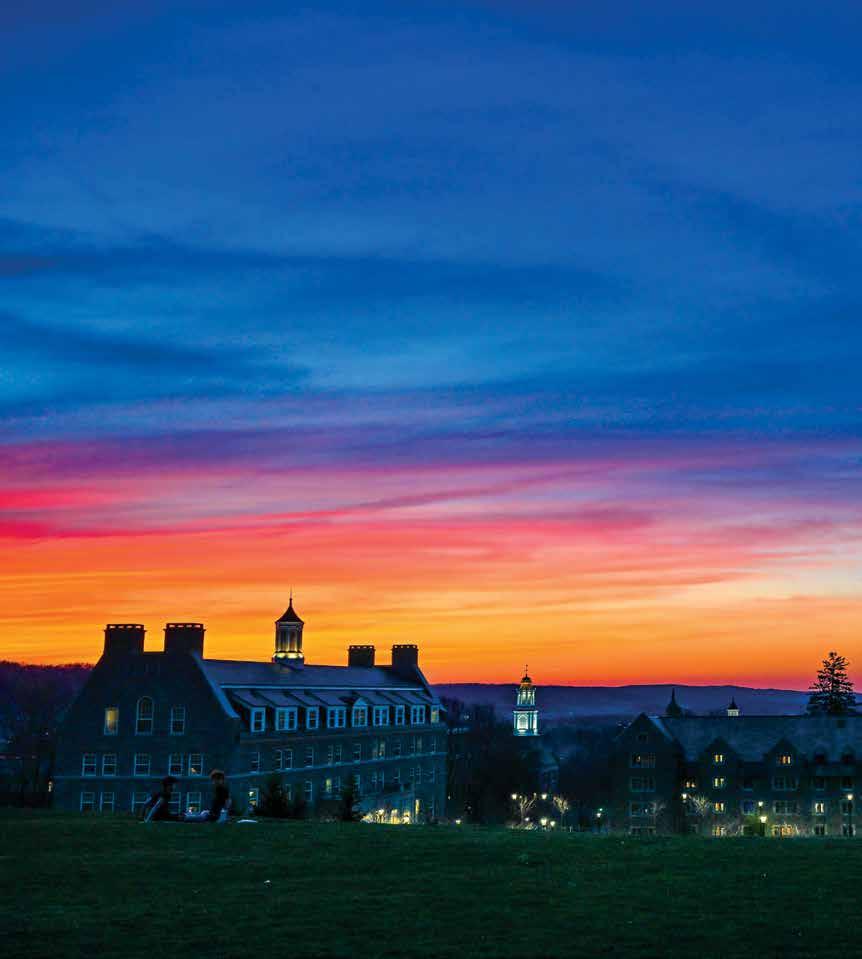
mark diorio
look
A sunset to remember on a weekend to remember. This photo was taken from Raab House (the president’s house) during a private meetand-greet reception with ballerina Misty Copeland, who was the keynote speaker for Colgate’s inaugural Arts, Creativity, and Innovation Weekend. For more about the weekend, see p. 18.
Read this issue and all previous issues at colgate.edu/magazine.
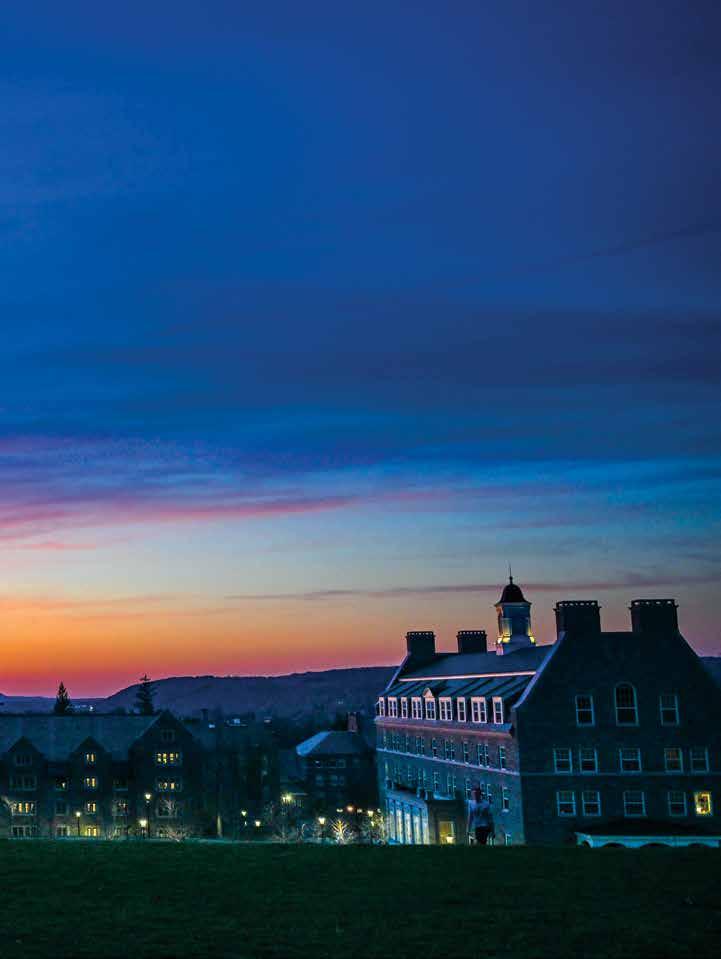
Summer 2023 Colgate Magazine 1
Hats off to the Class of ’23. During the 202nd Commencement, 687 graduating seniors received their bachelor of arts degrees. Jazz legend Wynton Marsalis, who was the commencement speaker, gave them six key pieces of advice. For more, see p. 12.
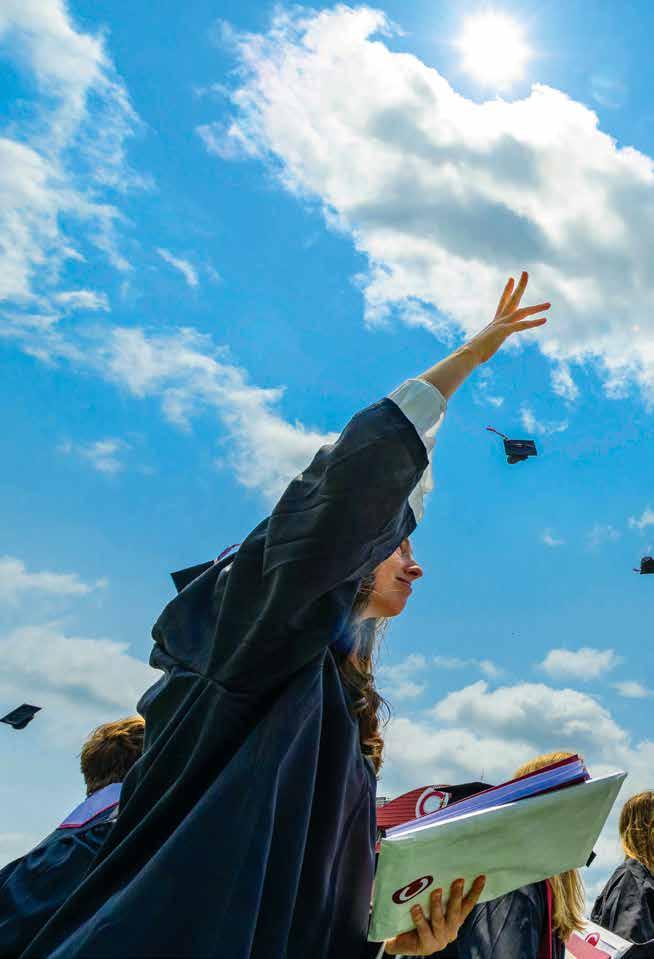
2 Colgate Magazine Summer 2023
look

Summer 2023 Colgate Magazine 3 mark diorio
SUMMER 2023
Professor Joel Sommers’ Smithsonian Showcase
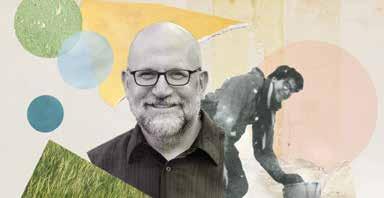
A Colgate computer science professor’s research is included in a new exhibition at the Smithsonian National Museum of Natural History.
My Step Across the Pond
A Case of Dubious Provenance
Looted antiquities were seized from the Met, with the investigative support of Professor Elizabeth Marlowe.
A Broad View: Investing in Student Life and Our Residential Tradition
Colgate is rebuilding and renovating housing for its juniors and seniors, creating a new University region, the Lower Campus.
U.S. Congresswoman Mary Gay Scanlon ’80 is not afraid to speak up.

She never wanted to go into politics — but when she made up her mind to do so, Scanlon became a congresswoman fighting for the underrepresented in her district and nationally. 32
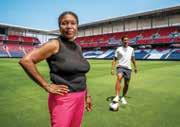
Jazz, John Coltrane, and Crooning
Saxophonist John Coltrane only ever invited one vocalist to collaborate on an album. Why did he choose Johnny Hartman?
My Colgate research motivated me to become:

4 Colgate Magazine Summer 2023
state archaeologist, an EPA ecologist, a U.S. Geological Survey scientist, an immigration policy changemaker… 38 President’s Message 6 Voices
A
as Joan Westcarr ’86 Gioacchini was about to move
family to Paris, a crisis occurred, leaving her with many uncertainties. 8 It Takes Two A box Peter Oltchick ’91 found in his late father-in-law’s basement led him on an eight-year journey. 10 Scene Colgate News 12 Discover Sharing the Wealth Employee ownership gives people incentive to work harder and smarter. 22 Contents
Just
her
26
Congresswoman Mary Gay Scanlon ’80, p. 32
Cover: Congresswoman Mary Gay Scanlon ’80 in the Cannon Building, the oldest congressional office building, in Washington, D.C.
Photo by André Chung
23
24
25
Endeavor
Immersive Worlds of Wonder
Flower Power
Vice President for University Outreach and Chief of Staff to the President
L. Hazel Jack
Managing Editor Aleta Mayne
Assistant Editor Rebecca Docter
Assistant Vice President, University Communications and Strategic Initiatives Mark Walden
Senior Art Director Karen Luciani
University Photographer Mark DiOrio


Communications Specialist Kathy Jipson
Contributors: Omar Ricardo Aquije, athletics communications manager; Kelli Ariel, web manager; Daniel DeVries, assistant vice president, university communications and media relations; Mary Donofrio, advancement communications director; Jordan Doroshenko, director, athletic communications; Garrett Mutz, senior designer; Brian Ness, senior multimedia producer; Kristin Putman, senior social media strategist; Amber Springer, web content specialist
Printed and mailed from Lane Press in South Burlington, Vt.
Colgate Magazine
Volume LII Number 4
Colgate Magazine is a quarterly publication of Colgate University. Online: colgate.edu/magazine
Email: magazine@colgate.edu
Telephone: 315-228-7407
Change of Address: Alumni Records Clerk, Colgate University, 13 Oak Drive, Hamilton, NY 13346-1398
Email: alumnirecords@colgate.edu
Telephone: 315-228-7453
Opinions expressed are not necessarily shared by the University, the publishers, or the editors. Colgate University does not discriminate in its programs and activities because of race, color, sex, pregnancy, religion, creed, national origin, ancestry, citizenship status, physical or mental disability, age, marital status, sexual orientation, veteran or military status, predisposing genetic characteristics, domestic violence victim status, or any other protected category under applicable local, state, or federal law. For inquiries regarding the University’s non-discrimination policies, contact Renee Madison, Title IX coordinator and vice president for equity and inclusion, 13 Oak Drive, Hamilton, NY 13346; 315-228-7014.
Summer 2023 Colgate Magazine 5
An experiential event company founded by Robert Drury ’99 invites people into real moments of the shows they love. 46
Landscape
thinks about climate change as much as aesthetics when she styles gardens for her clients. 48 Telling The Handmaid’s Tale Catch up with writer Jacey Heldrich ’08 ahead of the show’s sixth and final season. 49
Jerry Roscoe ’75 was called to mediate the Dominion-Fox case while on vacation.
Alumni News 50 Salmagundi 97 Tracy Messer MA’83, p. 68
designer Lynn Becker ’78
When
I was brought up, I was taught that when parties need you, you respond.
p. 63
President’s Message
Since 2016, my focus as president has been on securing Colgate’s position as a great American university. Reunion 2023 attendees heard me discuss the six steps that any college president must take to accomplish such a task. Through this column, I put those six steps before the entire Colgate community. These are, inevitably, the guiding principles of the Third-Century Plan, which calls on Colgate to renew its campus, attract ever greater levels of talent, invest in academic excellence at every turn, and offer an undergraduate experience equal to the very best in the country.

These steps are behind the bold decision to raise $1 billion through our Campaign for the Third Century. And they are reflected in the stories you will see in this and every — edition of Colgate Magazine.
THE STEPS
STEP 1: Be appointed to a university with a tradition of greatness.
If you hope to guide a college to excellence, it is best to begin in a place where greatness is a tradition. I was fortunate enough to do just that. Every college is distinct, with its own DNA, culture, and personality. The job of the president is to find the innateness of the place and strengthen it. Colgate, thankfully, has a distinctive energy and the will to achieve preeminence.
STEP 2: Assemble a strong team.
The public in general, and Colgate alumni in particular, will not often see this presidential function — that is, managing a team — in action. Yet it is possibly the most important thing I do. As president, I must constantly ask, “How do I form a remarkable, ambitious team? How do I encourage them to work together in service of a vision?” It is rarely discussed beyond the walls of the administration building, yet it occupies so much of my day.
STEP 3: Focus intensely on the essentials.
Staying focused is one of the hardest things to do when you work at a university. These are dynamic places, with many constituencies — faculty and staff members, undergraduates, alumni, parents, local neighbors, the national higher education press — all with their own voices, concerns, needs, and goals. Yet it is the president’s job to hear and acknowledge them while still advancing a unified vision for the achievement of the institution’s mission. That is the function of the ThirdCentury Plan, and that is why it was formed carefully through campus governance structures, in close
consultation with all constituencies. It is our North Star, the long-term road map we agreed to follow together.
Step 4: Demand excellence.
This is hard, too. As a president, one of my responsibilities is to look across the University, from its highest strategic efforts to the most mundane daily operations, and ask, “Are we taking an easy path just because it is easy?” or “Is there a more excellent way to do this?”
Colgate has its rhythms and rituals, and it can fall into patterns that feel comfortable. This is human nature, and Colgate is a place where smart, well-intentioned humans come together in pursuit of a shared mission. And we do most things well. We are, by almost every measure, in an extremely enviable position in the American higher education context. Why not keep things as they are? But every now and then, we must disrupt ourselves — before someone or something else does it for us.
One of the great secrets of American colleges and universities is that they are profoundly resistant to change. Regardless of what you might read in the media, universities are conservative institutions in many ways, seeking constancy. As president, you have to remember this little-known fact. So when you demand excellence, also know that you have an institution that has any number of ingrained patterns and reasons not to change. Every now and then you have to look at those ingrained patterns and demand something new. (By the way, no one likes this … at all. Trust me. But this is completely necessary.)
STEP 5: Be bold.
American colleges and universities tend to project a timelessness. We live and work in old stone buildings; we walk across centuries-old quadrangles. We project history and tradition.
But it is fundamentally true that, for all of that conservative instinct, institutions never really stay the same. A university is either improving or declining. Those are the only two directions available, given the remarkably competitive world in which we operate. You have to choose to be bold. It’s a conscious act. (And, by the way, most colleges and universities do not so choose.)
STEP 6: Find joy in this work.
I happily say that the job of a college president is difficult and relentless. The meetings start early and the events go late. Something complicated crosses your screen every day. And every decision you make will find its detractors.
6 Colgate Magazine Summer 2023 Visit Colgate.edu/ president
mark diorio
So, in order to be effective in this job, you must find joy in its rhythms, patterns, and requirements. I have seen so many of my peers lose that joy, and the institution suffers as a result.
On a personal note, making the campus beautiful is one source of joy for me. Walking my dog and seeing the students is a completely other source of joy for me. Hosting an event at which people are happy this is also a source of joy. I used to think these were unimportant things, small private things that I should keep to myself. I was wrong about that.
Where We Are
These six steps are the foundation of my daily routine. But they also provide
experience; and stewarding the physical campus. In each of these areas, the Plan asks, “Where are we demanding excellence, and how do we become better?”
It turns out that much progress is taking place in each of these areas. This year, more than 800 students are attending Colgate without loans due to the Colgate Commitment, our initiative in access and affordability. We seek to fully endow the current level of support, which removes loans for students with family income below $175,000, makes Colgate tuition-free for students with family income below $80,000, and covers other costs of attendance.
A dozen Colgate faculty members now hold new endowed chairs, answering the question, “How is the institution supporting
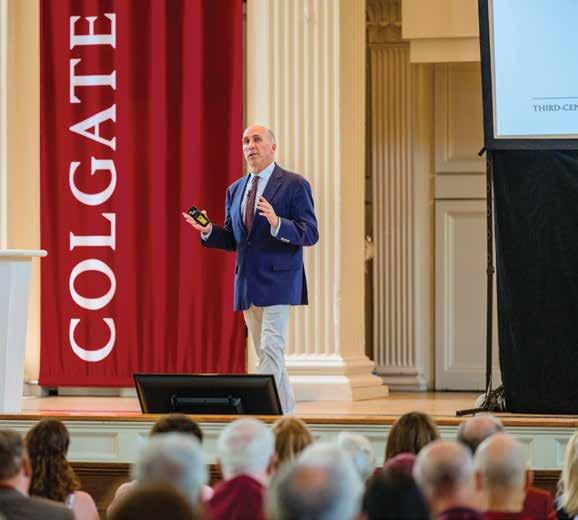
departments in the humanities and social sciences, is already underway.
The Benton Center for Creativity and Innovation is also rising — in fact, we shifted the reunion tents to the other side of Taylor Lake this year in order to accommodate the work that limited access to Whitnall Field. This project will ensure that explorations in film and media studies, digital art, computer science, music, dance, and theater all have a common locus on the Middle Campus.
Across Broad Street, we are in the initial phases of shaping the Lower Campus. This University has to make a multi-year, multimillion-dollar investment to ensure that our juniors and seniors live in residences that form and extend community. On a renovated and cohesive Lower Campus, there will be fraternities and sororities, theme houses, apartments — an entire West Row on 30 acres that are currently degraded parking lots. Read more about the development of the Lower Campus in the pages that follow.
Build It and…
This issue of Colgate Magazine reports both on the advances of the University and its community members. In addition to detailing our plans for Lower Campus, the summer edition brings you a conversation with Congresswoman Mary Gay Scanlon ’80, who represents Pennsylvania’s 5th district including part of Philadelphia. In true Colgate fashion, she saw a need for leadership in her community, and she stepped forward to take on that role. Today, she represents more than 700,000 constituents and serves on the Judiciary Committee.
You will notice that Mary Gay still draws on Colgate connections. She’s not alone this University is known as a place where strong relationships develop between professors and their students. It happens particularly when students join faculty members in pursuing scholarly research. Magazine editors were curious to know if research partnerships had an enduring effect, and they asked alumni for the ways in which those experiences shaped their lives. Many wrote in to finish the sentence, “My Colgate research motivated me to become….”
context for the Third-Century Plan, which is a way for us to maintain focus on — and change — the four most important things about an undergraduate college: attracting talent, whether students, faculty, or staff; strengthening the academic enterprise (the factor that changes an institution’s reputation over time and is the greatest challenge); enriching the student
its faculty?” We will expand that number to 20 during the course of the Campaign for the Third Century.
Construction on the Robert H.N. Ho Mind, Brain, and Behavior Center continues alongside the expansion and renovation of Olin Hall. Mind, Brain, and Behavior Initiative programming, which brings together biology, neurology, psychology, philosophy, and other
As you read these and other stories, catch up on your alumni news, and enjoy the summer months with family and friends, I hope you will embrace the six steps that can lead to greatness, too. Building on tradition, forming a team, focusing on essentials, demanding excellence, being bold, and finding joy in your work — these are steps that can be applied to any walk of life. Be well.
— Brian W. Casey
Summer 2023 Colgate Magazine 7
President Brian W. Casey addresses attendees of Reunion Weekend 2023 during The Third-Century Plan: An Hour With the President on June 3.
Voices
Reflection
My Step Across the Pond
Landing in Paris in the fall of 2016 was a blessing in disguise. After planning our move to the City of Love, one week before our departure, my husband of 23 years decided he was not coming. A hidden mistress for five years and a crippling substance abuse problem were the culprits. It was a shock for the entire family. He and I had already secured an apartment in the 12th arrondissement for our two 16-year-old boys and ourselves. Plus, I was excited for the expansion of our small pasta sales company in Paris — and, even better, watching our son Niko play football (soccer in the U.S.).
My first question was, do I stay or do I go? The tickets had been purchased; we had enrolled our other son, Chris, in school; and Niko was excited about his prospects of playing football in Paris. I had no friends, no foundation, and knew no French. But, Paris did offer one thing: the opportunity to write a new chapter in my life. The city had no memories, smells, places, or people that would remind me of the person and life I was leaving behind. So, I threw caution to the wind and we boarded the plane.
Initially, my daughter, Alexia, remained behind because she had been scheduled to begin her first year at university in Maryland. However, the trauma of her favorite parent abandoning her broke her spirit and will. I suggested that instead of heading to college, she should take a gap year in Paris to collect herself.
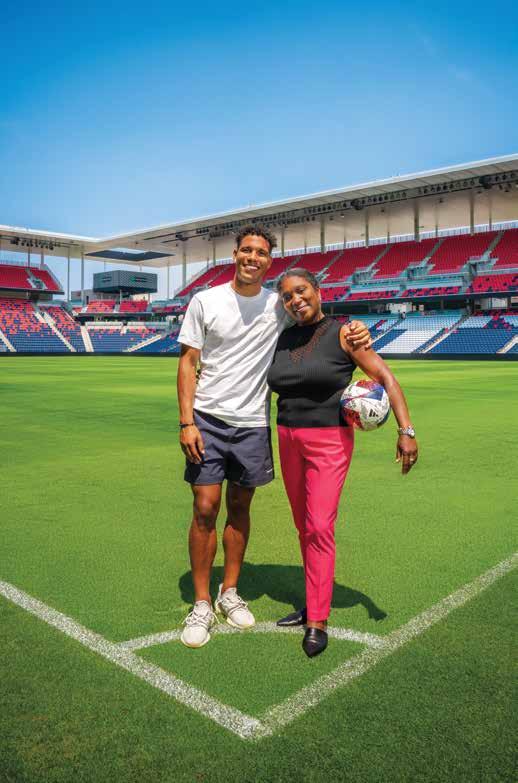
My kids had been the core of my existence since 1998. That’s when I had given up a budding television journalism career in Washington, D.C., to become a stay-at-home mom and to help run our family business. My commitment to my children’s happiness, health, and peace became my top priority. The unforeseen rupture of the family dynamics fueled my desire to protect them even more. Especially because I had plucked them from their safe, familiar surroundings in Maryland and had replanted them in a new, unfamiliar place, I had to help them find peace. Their peace was my tranquility, and thus my ability to thrive.
Caption ebissim de simendus eos id quam faccus dolutem quis
The first child to settle was Chris. He was still in high school and hated the move to Paris. We had lived in Italy from 2008–12, then landed in Bethesda, Md. Chris had carved out his friend group and a rhythm he enjoyed there. Paris disrupted this. Regardless of his wishes, he was dragged along. Enrolling him at a private English school in the city, I hoped it would provide a supportive environment and new friends.
Initially it was challenging for Chris. He had unenthusiastically traded his school bus for the Paris metro. He had never had
8 Colgate Magazine Summer 2023
kevin roberts
Joan Westcarr ’86 Gioacchini looks back on her experience living in Paris and helping her children acclimate.
Joan Westcarr ’86 Gioacchini and her son Niko
to navigate any route by himself before, but within a brief period, he learned to hop on and off the trains like a pro. Also, his fresh new uniform — that consisted of a pink-andwhite pinstripe button-down shirt and navy blue trousers — made getting prepared each morning a breeze. Within a matter of weeks, our dinner table conversation included Chris chatting about his new friends and describing his new teachers. One down, two to go.
After her gap year, Alexia had decided to remain in Paris. This time helped her flush out her mind and clear away the haze. We had even grown closer. She had originally been tight with her dad, but days and nights spent together discovering restaurants, shops, and galleries had created our bond. At night we shared the same bed, lulling each other to sleep by talking about our fears, dreams, loves, and hates. I had never imagined that my daughter and I could be so close. University was next on the agenda. Alexia did not speak French, so we hunted down the one and only Englishspeaking liberal arts university in Paris, the American University of Paris. Alexia and I visited the campus and chatted with a few parents and faculty members. The majestic campus buildings and chic neighborhood restaurants that dotted that area in the 7th arrondissement made the choice easy. Sipping champagne in crystal glasses while staring at the Eiffel Tower sealed the deal. Alexia enrolled for the fall of 2017. Two down, one to go.
Niko’s road was a bit more challenging. Because he was not on the standard educational path, I had to navigate different routes for him. His education had to continue because he had not finished high school, but football put a curveball in getting him into school. Niko’s football skills had landed him, at the age of 16, as the starting striker for Paris Football Club’s Under 17s. This was quite an accomplishment for an American player, especially one without an agent or agency behind him. But he was not allowed to attend the soccer high school because he did not speak French and the English high school conflicted with his practices — so I had to be creative in finding him an alternative. The middle ground was hiring English-speaking teachers, in five disciplines, to teach him the required subjects at home. This worked for one year, but I had to switch him to an online school to pursue an actual diploma.
During this time, Niko was scoring goals left and right. This caught the eyes of many scouts, agents, and coaches. His career was about to begin. My job had always been to make sure he ate well, practiced well, got
enough rest, and did his schoolwork. After all, I had been handling his football career since he was 6 years old, so I felt in my groove. However, this time it was trickier. We were now in the football mecca of the world, and there was more at stake. I didn’t speak French, I didn’t know the French football system, and I was a Black woman in a white, European, male environment. Minor details, I thought.
I showed up at all of Niko’s games, no matter where they were. Once, I drove five hours to see him not play; he had been benched. It didn’t matter. I had followed every one of his games and tournaments in the U.S., and I wasn’t going to stop now. Watching his performances was crucial if I wanted to continue to guide him. My presence was also important for his psyche because he was a foreign kid playing in a foreign land.
Scouts and agents became my social partners during the games. Although I didn’t understand much French, they all spoke enough English to communicate. Niko had potential, and many of them wanted him to sign with them, but they all knew that they had to convince me first. I was flattered to be in this situation, but I was also very stressed. It was my son’s career, and I didn’t want to make any mistakes. I had heard horror stories of young players who had signed contracts that shut down their careers for life or poor decisions that had turned clubs away. I needed to learn what to do and learn quickly. Humility was the key. I never assumed I knew anything, even when I did. This propelled me to speak to every agent, friend, and family willing to talk to me. I asked questions and cross-referenced info from one football person to another. Patterns as well as contradictions from
coaches, clubs, and agents began to show. Discerning who was blowing smoke from who was spitting facts started to become clear. Identifying the stark difference between football the game and football the business helped me navigate Niko’s career. After getting his high school diploma at 18, Niko signed his first semi-professional deal with S.M. Caen, a top-tier team in France. One year later, he was called up to the U.S. Men’s National Team.
Chris made his way through high school and college, graduating with a degree in sports marketing. Alexia wrapped up her degree in three years and plunged into the world of French fashion. Her involvement in Paris Fashion Week, vintage shopping, and TikToking has helped her to become a stylist in the U.S. All three of my children mastered French, adding to their English and Italian.
During this time, I didn’t forget about my own personal growth. Being in Paris was a huge cultural and artistic education. Food, architecture, art, history, and culture were everywhere. It had felt a bit like our years spent in Italy, but this time the language was my greatest challenge. I committed to a few local French courses but absorbing it proved difficult. Maybe the distraction of a divorce taking place thousands of miles away and the focus on my son’s football career made for very little space in my brain.
Because the divorce had eliminated my involvement in our family business, I comfortably fell back on my original career. Once per month, I began contributing to a local English online radio station. Occasionally, I was a substitute teacher at the American School of Paris and eventually taught writing at the American Business School of Paris. As challenging as these additional gigs were, they allowed me an opportunity to expand my social group, to weave myself into the local community, and to temporarily escape the football arena.
Looking back on my experience, Paris brought me so much growth. It gave me the chance to clear my head and start fresh. It opened my mind to new people and a new environment. It transformed me into a stronger-minded, more confident and observant person. It even gave me insights, knowledge, and contacts into the world’s biggest sport while breathing life into my new career: soccer management.
Joan Westcarr ’86 Gioacchini continues to manage the career of her son Niko, who now plays for the St. Louis City (Mo.) Soccer Club.
Summer 2023 Colgate Magazine 9
I didn’t speak French, I didn’t know the French football system, and I was a Black woman in a white, European, male environment. Minor details, I thought.
Book
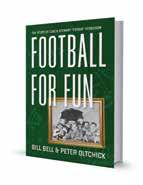
It Takes Two
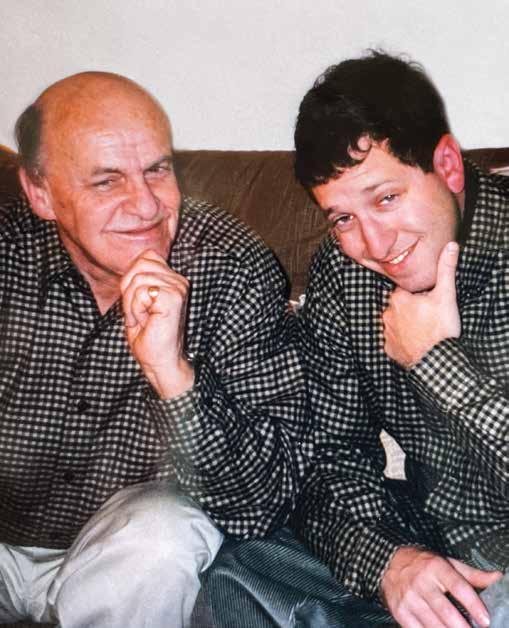
An unwavering curiosity becomes a labor-of-love project for Peter Oltchick ’91.
couldn’t not open the box in my mother-in-law’s basement.
Inside was a perfect mess of my late father-in-law’s book research: chicken-scratch scribbles across mounds of cocktail napkins, backs of envelopes, bits of small sheets — including remnants of an amorously illustrated à faire aujourd’hui (to do today) notepad, scattered index cards, sectioned thick spirals (via fraying Post-it notes), and of course, his trusty 8" by 4" Daily News notebooks.
An acclaimed lifelong journalist who

voices
Bill Bell (left) and Peter Oltchick ’91
I
teacher. The hard-to-fathom story of Coach Stewart Ferguson — later known as “Fergie” — was in motion. Battling failing health, Bill would make a strong push to capture Coach Ferguson’s turbulent and defining earlier years.
Upon scanning several of Bill’s chapter files, I, too, was hooked by the fascinating Fergie and felt a strong pull to shape the book into a biography. I was especially energized to dig into Fergie’s later years, in which he, as a high school football coach, left an indelible imprint on the Black Hills’ still frontier town and close-knit community of Deadwood. I reset to full-research mode, channeled my days as sportswriter and editor of the Colgate Maroon (pre 1992 merger with the Colgate Snooze [couldn’t resist]) and went about trying to walk in Bill’s — and Fergie’s — footsteps, which led me to Arkansas, Louisiana, and across South Dakota.
As for the whole writing part, I started with some simple internal marching orders: Don’t screw this up! This maybe wasn’t the most productive approach, so I pivoted to something more positive, though hardly pressure free: Do right by Bill Not surprisingly, my overriding thoughts focused on ensuring the final manuscript would read as one voice. To address early agita around revising, moving, or deleting any of Bill’s content, I leaned on a healthy dose of color-coded fonts and annotated strikethroughs; every new draft specified what changed from the previous version. If a prospective publisher wanted the play-byplay “save as” anatomy of a manuscript, I’d be ready.
Eventually, the multicolor fonts faded, the strikethroughs disappeared, and voices evolved into voice. A spectrum of doubts shifted into a semblance of rhythm and ascending confidence. At a certain point, who wrote what was no longer a thing, which felt freeing. Writing and rewriting became solely about serving the story — sharing and celebrating Fergie’s wild ride.
Reflecting on the entire labor-of-love process, I gravitated to some narrative nonfiction guideposts that kept me on track. Holding on to the story — and character — helped me focus on Fergie’s journey and ensure the reader rooted him on through his multiple missteps. I also slowed down when necessary and embraced all the circuitous paths of the research process, realizing that surprises and new nuggets could be around the corner. In fact, some of my favorite finds came from allowing myself to just read and learn. This was particularly true as I consumed late 1800s to early 1900s newspaper issues of the Deadwood Pioneer-
Times and the Lead Daily Call and worked to understand the complex relationship — and bitter rivalry — between the twin Black Hills cities.
For interviewing Deadwood High School alumni, I ensured I was extra prepared. The due diligence around gathering old photos and accumulating football gameday details were essential triggers to spark specific decades-earlier memories and other revealing insights. Nearly as important was actively listening.
Through it all, I fought myself to perfect wherever possible but try not to demand perfection.
Approximately eight years after I peeked inside that big, dusty box, the whirlwind of feelings came roaring back when I was preparing the book’s acknowledgments. Dubbed by his family as “the thing in the basement,” Bill had the unique ability to do a crossword, play guitar, read, watch college football, belt out Johnny Cash, and nap all at the same time. Yeah, and as a lifelong newspaperman, he could also bang out stories with the best of ’em.
Those stories took Bill literally around the world for the United Press International — from South America to Europe and Africa — before he settled down in Connecticut and started up at the New York Daily News Spending years as the religion editor and “City Beat” columnist, he was a witty, gritty, wise, and beloved newsroom figure. While his newsroom buddies knew how excited Bill was about his second act as an author, I only became acutely aware after stumbling upon a document during some additional Connecticut basement book research. Circa 2004, Bill Bell typed up the not-so-little, therapeutic ditty It didn’t take this long to… Enjoy one of the 53-strong beauties, a nod to Fergie’s religion-centric musings in the book: “It didn’t take Adam this long to convince Eve they should be more than friends.” On Bill’s behalf, I’m thrilled the wait is finally over.
This essay by Peter Oltchick ’91 includes text from a forthcoming book by Bill Bell and Oltchick, Football for Fun: The Story of Coach Stewart “Fergie” Ferguson (South Dakota Historical Society Press, September 2023). Oltchick is also the author of the children’s picture book Clean Clara. He says 13 is indeed his lucky number, thanks to both of his kids’ birthdays (including one on Colgate Day!). He can be reached at pjo24@yahoo.com.
“We write the script as far along the process as we can so we don’t write for one particular character … so we keep it very diplomatic. Towards the very end of the process, then we cast … it just sort of organically happens.”
— Erik Stolhanske ’91 of Broken Lizard talked to the Post-Standard (Syracuse, N.Y.) about the comedy troupe’s new film, Quasi.
“It’s about always keeping focused on the university’s educational mission, it’s about working across differences to build new relationships and it’s about being open to diverse voices, while also caring about their effects on others. These benefits stay on campus long after a visit is over.”
— Professors Spencer Kelly and Yukari Hirata wrote an Inside Higher Ed editorial on “Preparing the Campus for a Controversial Speaker.”
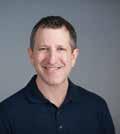
“A new political framework agreement is needed that is inclusive and that has the trust and support of Sudanese people.”
— Professor Tsega Etefa (history and Africana and Latin American studies) explained the Sudan crisis to The Conversation.
“The other thing that we’re trying to do more and more of is train faculty, staff, and sort of the student body generally on noticing warning signs, and talk to them about how to talk to others when they’re concerned about them and then refer them to those resources.”
— Colgate’s Assistant Vice President of Counseling and Psychological Services Dawn LaFrance discussed college students’ mental health on Eyewitness News Channel 20 (Utica, N.Y.).
Summer 2023 Colgate Magazine 11 voices
IN THE MEDIA
sound?’ and he said, ‘You have to love yourself.’”
SCENE
Commencement Advice From Wynton Marsalis
Seated, as commencement speaker Wynton Marsalis observed, “in a cocoon of feeling and surrounded by your people,” 687 graduating members of the Class of 2023 received their bachelor of arts degrees May 21.
Jazz trumpet legend Marsalis, the artistic director of Jazz at Lincoln Center, director of the Jazz Studies Program at the Juilliard School, and president of the Louis Armstrong Educational Foundation, made six simple requests of the graduates — actions they can “easily realize with minimal fuss every day of your lives, without wasting time, energy, words, or money.”
→ Be present. “Experience things as they happen. Life is more interesting when you allow it to set your banquet table. Don’t get involved in curating your life. Let your phone do that for you. Be present and let the intensity of your participation shape your feeling, not the act of you observing your participation in your own experience.”
→ Be where you are. “The paths to knowledge are as varied as there are individuals in this world. We cannot be on all roads at once. When we wish to experience all things at all times
we end up with nothing … revel in the general spirit that defines this place. Wherever you may find yourself, take the organic lesson in community building that you have learned here.”
→ You might not be on time, but be in time. “The present is your safest and only practical choice. Be in time and you will be flexible enough to define yourself and your experience more broadly than your age, hairstyle, clothing, or favorite popular video, app, or platform. Be in time and you will maintain your equilibrium when the next war or financial crash or mass act of violence occurs. Be in time and you will come to see the value of singing, dancing, cooking,
storytelling, playing, laughing, and many other tactile human interactions that are not in our clichéd vision of a technological future. Be in time, because the people all around you are the real technological marvels, and how we interact with each other is the most fascinating study on this earth. Be in time and you will never underestimate the impact of your disposition in any tough situation that you may encounter.”
→ Be yourself and be fabulous. “I am reminded of the great trumpeter and sage raconteur Dizzy Gillespie, who had a request for me…. In 1980, when I was 18 or so, I asked Dizzy, ‘How can I find my own personal
→ Be grateful. “I don’t want you to let a day go by that you don’t bow your head and acknowledge all that you have been given and acknowledge all that you give, and also all the blessings that you have received.”
→ Be cool about it all.
In addition to the cool — and sage — Marsalis, who received an honorary doctor of arts degree, Colgate conferred honorary degrees upon four other distinguished individuals: Joseph J. Castiglione ’68, Boston Red Sox Radio broadcaster; Ilya Kaminsky, poet, editor, and professor of creative writing at Princeton University; Mary Ann Moran ’77, University of Georgia Foundation distinguished professor in the Department of Marine Sciences at the University of Georgia; and Mark S. Siegel ’73, founder and president of ReMY Investors & Consultants, Inc.
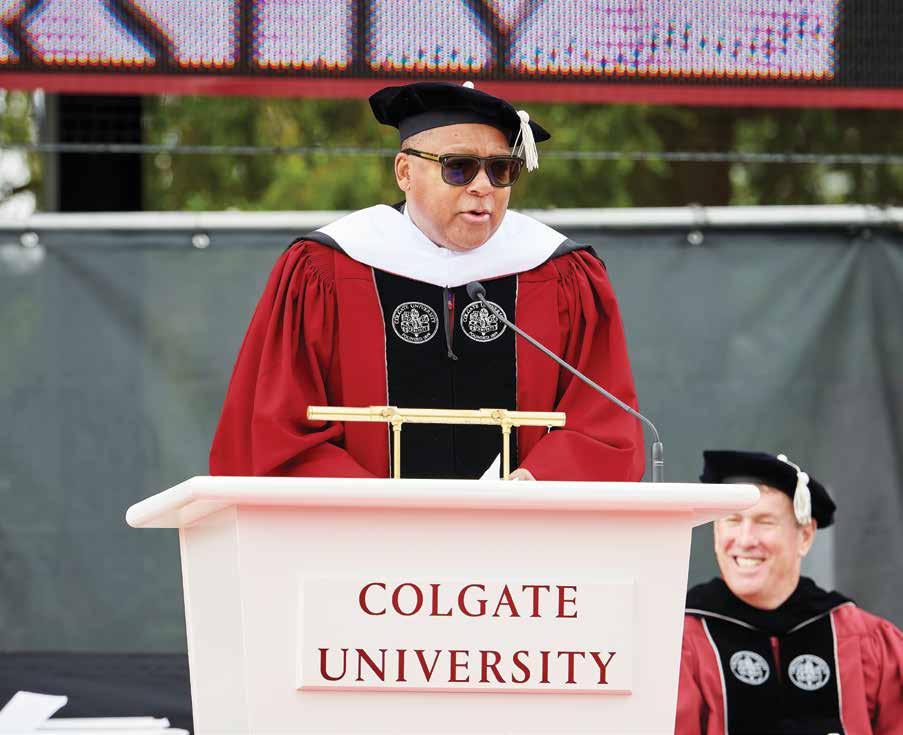
Class valedictorian Caleb Levy ’23 of Kingston, Jamaica, graduated summa cum laude with high honors in physics. The salutatorian, molecular biology major Matthew Sampson ’23 of Fairport, N.Y., also graduated summa cum laude and was elected to Phi Beta Kappa. In addition to those earning bachelor’s degrees, six graduate students earned the degree of master of arts in teaching with distinction and one, a master of arts with distinction.
Caption ebissim de simendus eos id quam faccus dolutem quis re con exeruptus aut
“To be where you are now, to have persevered through all that you have, is a singular mark of achievement, a mark of strength and courage,” President Brian W. Casey told the class. “You are to be recognized and admired for such perseverance and work. You were the class that history touched, now a class entering a changed world. You are ready now, ready for that changed world — even if, at this very moment, winds are blowing and you are cold, you might not feel that way. You are.”
— Rebecca Downing
12 Colgate Magazine Summer 2023
andrew daddio
Wynton Marsalis addresses the Class of 2023.
CAMPUS LIFE | ART | ATHLETICS | INITIATIVES |
CULTURE | GLOBAL REACH
Student Tax Prep Volunteers Help Return $1.47 Million to Local Residents
This year, students in Colgate’s Volunteer Income Tax Assistance (VITA) program returned $1.47 million to residents living in Madison and Chenango counties. The program began in 2004 and has been led by Nicole Simpson, W. Bradford Wiley Professor of international economics. It is funded by the University’s Upstate Institute and NBT Bank.
Each spring, 15–20 students help low-income, local residents
file their federal and state income taxes free of charge.



The program allows most VITA clients to claim the Earned Income Tax Credit and saves local families hundreds of dollars in tax preparation fees.
VITA also gives Colgate student volunteers an opportunity to gain real-world tax preparation experience and help support low-income families in the community. The program is in coordination with the C.A.S.H. (Creating Assets, Savings and Hope) Coalition of Madison and Chenango Counties.
Learn more:
→Simpson teaches the course Volunteer Income Tax Assistance (SOSC 275), where students learn about the complexities of the U.S. income tax system and the role of the Earned Income Credit and Child Tax Credits in pushing
hundreds of local families out of poverty. Student volunteers are trained and must pass an IRS certification test before working on returns; many of the students participate in the program for several years.


→More than 12,500 tax returns have been filed through the VITA program since 2004, with more than 80% of clients returning year after year.
→The VITA program currently serves 700–800 households a year, and continues to assist new clients each year.
→The average tax return of a VITA client represents more than 20% of their annual income (with the average income around $30,000).
→VITA services have saved local families more than $200,000 in tax preparation services per year.
— Stephanie DeVries
13 bits
1
CNN
2
3
Psychological
4
Students
5
For the third year, Colgate was awarded the CPN Seal of Prevention by education company Vector Solutions, recognizing the University’s work in 2022 on issues such as mental health, alcohol misuse, sexual assault, and discrimination.
6
— U.S. Sen. Kirsten Gillibrand announced the $50 billion Rebuild Rural America Act at Colgate’s HUB in downtown Hamilton.
Summer 2023 Colgate Magazine 13
senior political analyst and columnist Gloria Borger ’74 was honored with a Washington Women in Journalism Award.
The Red Carpet: John Cremins ’24, Ellie Johnston ’24, and Chris Mardirossian ’24 interned at the Cannes Film Festival through a partnership with The Gotham, headed by Jeffrey Sharp ’89.
science major and OUS scholar Katherinne Bertrand Ortiz ’23 is this year’s recipient of Colgate’s 1819 Award.
in Colgate’s Teacher Preparation Program raised approximately 75 brook trout to learn the value of having a fish tank in the classroom.
Eddie Watkins and Ephraim Woods received the 2023 Jerome Balmuth Award for Teaching.
Economics
Quotable
“Smaller rural areas like this play such an important role in this state. The programs you offer through the Partnership for Community Development are a great example of what the federal government should be doing in communities like this.”
Cynthia Ortiz-Naranjo
Linda Wang ’23
Lalana Sharma ’24
8
9

5 Questions for Ava Wigdor ’23
10
Her capstone film confronts the complex feelings that accompany the transition from college to the real world.
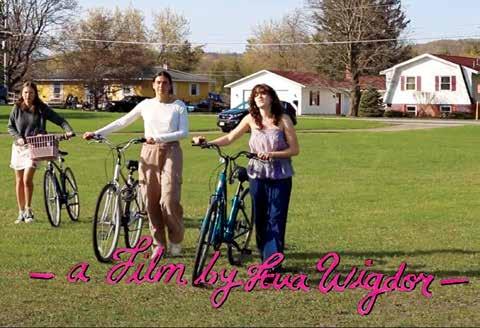
11
The period right before graduating can be a time when students grapple with a mixture of anxiety, nostalgia, and fear. In her capstone film, Supercut, Ava Wigdor ’23 captures this apprehension students feel when they’re on the cusp of stepping into unfamiliar territory. Shot on campus and in the surrounding Hamilton area, the short film features her close-knit group of friends. The piece delivers as a heartfelt thank you to those peers with whom she has grown and will continue to have by her side as she faces the uncertainties of post-graduation life.
13
Give us some background on the film.
“Supercut was a film of firsts. It was the first time I had written a screenplay, created a storyboard, directed actors, and filmed a narrative story. Everything was new, which was really exciting
but also challenging. I knew I wanted to make a fiction short film for my capstone project because it was something I had never done before, and it is something that I am interested in doing for a career.”

What is the meaning of the title?
“Supercut comes from the Lorde song about looking back at a series of clips of the best moments of something cut all together. My film does this in a similar way by stringing together all the best moments of college filled with friendship and happiness — because these are the moments I hope to remember.”
Describe the process of writing and directing the production.
“I came up with a rough outline at the beginning of the semester based on different scenes I envisioned and then wrote the script. It starred my best friends because I was writing it the way we all speak, so I thought it would sound the most natural coming from them. It is also about the closeness of female friendships: I wanted to capture that genuinely, and the chemistry was already there because we are all best friends in real life. Blythe Berk ’23, Lily
Grossinger ’23, Juliette Daignault ’23, Ava Horn ’23, Kai Dasbach ’23, and Lucy Bischof ’23 had the main roles. Chris Mardirossian ’24 was the production assistant.”
What was your inspiration for creating this piece?
“I have always loved comingof-age movies but found that the solution to all of them tends to be the main character going to college as if that means everything will be figured out there and will fall into place. As I got to this weird transitional time before graduating, I felt like I definitely did not have things figured out. I wanted to make a movie about this period of my life to show that I had not yet come of age, and I did not want there to be a clear ending of what comes next at the end of the film because that is not a reality I or many others in my position can relate to.”
What are your postgraduation professional plans?
“This summer I am participating in The Gotham EDU Film and Media Career Development Program. I am hoping to find a job in the film industry in the New York City area following this program.”
About Wigdor: The Montclair, N.J., native majored in film and media studies and minored in sociology. This past year, she was the leader of the Swinging ’Gates and hosted a WRCU show called Fecta Radio with two of her best friends, Berk and Grossinger.
— Paige Baker ’24
14 Colgate Magazine Summer 2023 SCENE ▼
7
Mexican Consul General in New York Jorge Islas López visited campus to discuss collaboration between the University and higher education institutions in Mexico.
Professor Danielle Lupton has been named a research fellow at the Modern War Institute at West Point.
The National Weather Service recognized Colgate as StormReady® — committed to being prepared for hazardous weather.
Men’s rowing varsity eight earned bronze at the Dad Vail Regatta.
Mark Pascale ’93 was named director of the Intelligence Project at Harvard Kennedy School’s Belfer Center for Science and International Affairs.
12
Volleyball’s Julia Kurowski ’22, MAT’23 and basketball’s Tucker Richardson ’23 were Athletes of the Year at the Golden ’Gates.
Head Men’s Hockey Coach Don Vaughan is retiring after 30 years; he is the winningest coach in program history.
FILM
Sampling the Seafloor
Students embarked on a research trip to the Gulf of Mexico.


To understand the effects of anthropogenic environmental changes on coastal ecosystems and their inhabitants, Professor Paul Harnik and five students embarked on an ambitious research trip to the Gulf of Mexico from May 22 to June 9.
The primary objective was to investigate how climate change and nutrient pollution in coastal environments in Louisiana and Alabama have impacted the biodiversity of marine communities and species’ ability to adapt to these changes. These coastal environments were not systematically studied before the 1970s when monitoring efforts began. Harnik and his team aim to fill the knowledge gap by examining historical data from these settings.
“Humans have been interacting with coastal environments since our species evolved many millennia ago, so it’s hard to figure out to what extent we are changing our coasts if we don’t know what they were like at different points in the past,” says Harnik, assistant professor of earth and environmental geosciences. “Our goal is to use the tools of paleontology to fill in these gaps in the record.”
The team collected sediment samples from the seafloor by working from boats off the coast of Louisiana and Alabama in collaboration with marine labs in each region. The process involved a meticulous approach. First, the team utilized a box core, a metal structure with weights, which was dropped onto the seafloor. Then, once retrieved, the sediment was carefully sifted through to separate living organisms from the remnants of past populations. And finally,
these collected samples were brought back to campus for further analysis.
By analyzing these samples, the team will begin to unravel how marine species have responded to warming, nutrient pollution, and deoxygenation over time, offering insights into the future of coastal ecosystems in the face of ongoing human activities.
“In the sediment that we draw up from the ocean floor, you have both living organisms as well as empty shells, the ghosts of populations past, who could have lived anywhere from yesterday to several thousand years ago,” Harnik explains. “By comparing and analyzing these two groups, we can begin to disentangle how those creatures are experiencing changing conditions as a result of human activities.”
Through analyses of these samples new and old, Harnik and his team can glean everything from how biodiversity and food webs have changed over time to how the chemistry of their shells records the environment in which they lived and how that environment has changed. These discoveries then equip the researchers with the tools necessary to more accurately predict how coastal ecosystems will change under future warming and ongoing human activities.
The student researchers played a crucial role in this research process, engaging in everything from data collection to analysis to the generation of their own datasets. “It was incredible to learn about marine organisms while actually seeing them in real life after having helped to collect them,” Ryan D’Errico ’25 says. “This handson experience in the field has made sorting and analyzing the samples in the lab feel more real, as I had a connection to the place [from which] the clams under the microscope originated.”
Working on the water for prolonged periods also had its share of challenges, including unexpected weather
and seasickness. Thankfully, Harnik, who has been conducting these trips for many years, has a number of countermeasures — everything from positive affirmations to recommendations for seasickness medications.
Above all, Harnik encourages the students to support one another and foster a sense of community within the lab. “The best way to produce good scientific work is by first looking out for one another’s well-being and staying engaged,” he says.
Alexa Russo ’25, who has been working in Harnik’s lab for nearly two years, adds: “When you’re on a boat in the middle of the ocean with the sun beating down on you, it’s easy to shut down, but Professor Harnik was able to help us develop ways to communicate,” she says.
By the time students returned home, they had a newfound understanding of and appreciation for our ocean ecosystem and the skills to continue learning about it further. Harnik emphasizes the importance of exploring these questions about human-ocean
interactions and their impact on our planet, regardless of where you live. “Whether you’re in Hamilton or the Gulf Coast, everything is linked to our ocean ecosystems,” he says. “It is a privilege to be able to study such a vast and important topic and also a responsibility. We must use the knowledge that we gain to contribute to the welfare of human communities and the ecosystems that we depend upon.”
— Bri Liddell ’25
Summer 2023 Colgate Magazine 15 SCENE
Paleobiology
Marie York ’26 and Cory Harper (Dauphin Island Sea Lab) deploy a box corer to sample the seafloor.
Check out a video of the trip, made by Mary Thomas Powell ’26, about her and her fellow researchers’ experiences in the Gulf of Mexico: colgate.edu/paleolab23.
Student Life Food Chain
What it takes to feed the campus community
To feed Colgate students, it takes a village — in Hamilton, the efforts include those of the Chartwells’ dining staff, the campus dietitian, and the Community Garden team.
packets, and soups.
“Hunger has many different faces,” says Bowers. “It may be that a student has moved off campus without a meal plan and cannot afford groceries, or that a student cannot afford balanced meals.”
Since their establishment in 2022, the pantries have reached students in need at an appreciable rate.
“We had about 41 people using the pantry last year,” says Esther Rosbrook, director of the ALANA Cultural Center. “Because it is an anonymous service, there may be even more than that number,” she adds.
Growing Together
crop from sprouts to shelves, where they are sold at a farmstand on campus.
“With the farmstand, it was rewarding to see our hard work


choose between a balance of comfort foods and pop-up stations, such as a build-yourown ramen bowl station or a rotating selection of meats in house-made sauces.
This spring, Chartwells welcomed Anthony Donofrio, the new executive chef. Donofrio brings a knack for what he calls “new American,” trendy cuisine to the dining team. Accordingly, Donofrio’s 12 years of industry experience at locations such as Modern Malt in Syracuse have been driven by his desire to innovate.
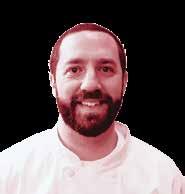
At the Shaw Wellness Institute, Campus Dietitian
Allison Bowers has offered nutritional guidance to students since 2021.
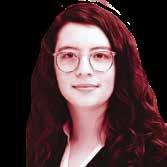
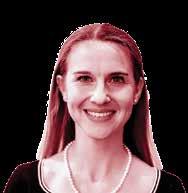
In Bowers’ experience, helping students develop a healthy relationship with food is a big help to young adults navigating their personal diets for the first time.
“One of the biggest themes I see across the student experience is that oftentimes eating patterns are representative of other parts of someone’s personal life,” says Bowers. “In my office, themes such as stress and adjustment to college living come up often.”
Bowers also bridges the gap between resources and foodinsecure students. She helps coordinate all three of Colgate’s on-campus food pantries, which are located at Shaw, the ALANA Cultural Center, and the Office of International Student Services. In each, Bowers curates a balanced inventory of meal alternatives and snacks, including granola bars, tuna
Colgate’s Community Garden offers an outlet for students to experiment with growing their own food by cultivating a large variety of produce. The garden began in 2009 as a senior seminar project in environmental studies, when it was established next to Newell Apartments. After several relocations, the garden settled into its current address on Route 12B in 2021.
pay off,” says Rachel Plasky ’25, one of the interns who saw the process from seeds to sales. “By bringing another healthy option to students, it allowed us to connect with those who were living off campus.”
A six-month growing season at the garden yields an average 3,000 pounds of fruits, vegetables, and herbs — half of which are donated to the Hamilton Food Cupboard. The other half reaches the campus community.
“This past fall, we were able to supplement the produce we bought with produce from the Community Garden,” says Don Stanwick, resident district manager for Chartwells. “As a staff, sustainability and local partnerships are important to us.”
Expanding Palates




Though Stanwick oversees all dining operations on campus, his work at Frank Dining Hall is the busiest. At Frank, students
He has introduced a variety of foods to Colgate’s dining halls, such as poke and Buddha bowls.

challenges to get where it is today,” says Garden Manager Beth Roy. “We’ve adapted to these challenges with the support of the University.”
Roy has served as garden manager since 2013. Each summer, she recruits a cohort of interns from the Office of Sustainability to cultivate the
“I’m influenced by what is going on in the culinary world, and honestly, it changes daily,” says Donofrio.
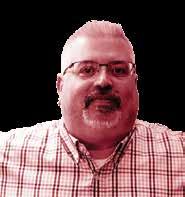


He also values the importance of making food from scratch. “You can taste the difference — when I can make a pico de gallo as opposed to buying a jar of salsa, it’s way better.”
And whether you start on the cutting board or from the ground up, fresh food is a labor of love — good food on a large scale requires a little elbow grease and a lot of commitment.
“It’s easy for people to come together when food is involved,” says Plasky. “Everyone eats, and is interested in food. But not everyone has the experience of growing their own. Now that I do, I understand what it takes to feed a community: collaboration and hard work.”
— Tate Fonda ’25
16 Colgate Magazine Summer 2023 scene
Athletics
Meet Colgate’s New Men’s Hockey Coach
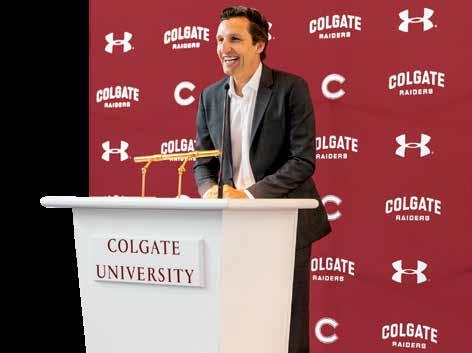
Mike Harder ’97 has been named the Donald F. Vaughan head men’s hockey coach. Harder returns to his alma mater after four years with Hockey Club Reno Ice; he previously spent six years as an assistant coach for Colgate. As a coach for the Raiders, he compiled 89 wins with a pair of ECAC Championship appearances and an NCAA tournament bid.
“It’s a tremendous honor to be coming back to Colgate,” Harder says. “I am beyond excited to be part of a program, institution, and community that have meant so much to me over the past 30 years. I look forward to being a part of Colgate’s future while continuing Coach Vaughan’s legacy of mentoring studentathletes both on and off the ice.”
Harder, Colgate’s all-time leading scorer, produced 214 points during his collegiate career. He graduated ranked fourth all-time in goals scored with 88 and second in assists for 126 points. He went on to earn 1997 All-America honors and was a Hobey Baker finalist. As one of the Raiders’ greatest to lace up the skates, Harder was elected to the Colgate Athletics Hall of Honor in 2008.
One of 13 nominees for The Hockey Humanitarian Award, Harder led the team in scoring for four straight seasons. A two-time All-ECAC All-Star, he won the Steve Riggs Memorial Award twice for gentlemanly play and a high standard of ability; the Rob Ries Memorial Award once for a player who provides inspiration and leadership; ECAC Merit Medal; and four times was named Colgate’s Best Offensive Player. He was named to the ECAC All-Rookie Team in his first season when he led the nation with six shorthanded goals, and Colgate in scoring with 46 points.
“I am very excited to welcome Mike back to Colgate and the Hamilton community,” says Yariv Amir, interim vice president and director of athletics. “Coach Harder will lead this program with high energy and enthusiasm. Player and skill development, influenced by his time playing professionally in Europe, plays an important part in his coaching philosophy and will be an
emphasis in training. Additionally, he will be a great ambassador on campus, within the community, and among Colgate’s hockey alumni.”
After earning his degree in international relations, Harder played 13 seasons professionally across North America and Europe. Included were stops in the American Hockey League (AHL) along with European League ventures in Germany, Austria, Finland, Sweden, and Italy. He helped Hartford claim the AHL’s Calder Cup in 2000 and was a key figure in a 2004 championship in the German Elite League of Deutsche Eishockey Liga.
Harder began his coaching career at Colgate in 2013–14 as a volunteer assistant. He played a key role in the program’s breakout campaign that saw the Raiders ranked 13th nationally in both major polls after advancing to the NCAA tournament as an at-large selection. After being promoted to assistant coach in July 2014, Harder was instrumental in guiding the Raiders to a 22-124 overall mark and an appearance in the title game of the ECAC Hockey Championship for the second consecutive season. During his time in Hamilton, Harder served five years as the director of recruiting. His first recruiting class led the nation in points and included a Hobey Baker finalist.
“In my time working with Mike, he showed an exceptional ability to connect with players, staff, and faculty,” says former head coach Don Vaughan. “His energy and passion are contagious. Colgate hockey is in good hands.”
As the founder and hockey director of Hockey Club Reno Ice, Harder spent the last four years building a program
and community from the ground up. He spearheaded the Reno Hockey Academy, a membership-based skills program. Today, the program has more than 500 youth players of all ages, a para ice hockey team, and a semipro team.
Harder returns to Hamilton as the 15th head men’s hockey coach in program history. He takes over a program coming off its first ECAC Hockey Championship since 1990 and first NCAA Tournament appearance since 2014.
The 2022–23 Raiders ranked No. 18 in the final USCHO poll of the season under Vaughan, who announced his retirement after being the third longest tenured coach in Division I. In 30 years behind the bench, Vaughan has the most wins in program history (470).
“From the time I arrived at Colgate as a first-year, Hamilton felt like home,” Harder says. “The warm people, supportive community, and ties between the town and University make it an unparalleled place to thrive. I’m excited to get started.”
— Jordan Doroshenko
Summer 2023 Colgate Magazine 17 scene
In my time working with Mike, he showed an exceptional ability to connect with players, staff, and faculty.
Former Head Coach Don Vaughan
Olivia Hokanson
Mike Harder ’97
Events
Colgate Celebrates
Inaugural Arts, Creativity, and Innovation Weekend


Misty Copeland, who is the first Black principal dancer with the American Ballet Theatre, kicked off Colgate’s Inaugural Arts, Creativity, and
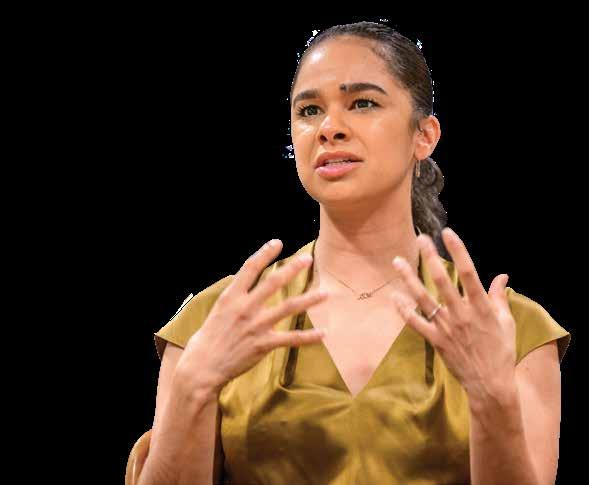
explained. “But ballet has become part of American culture, and it’s time to change the narrative to reflect who we are and what we look like. That’s the only way to stay relevant.”
Hundreds of alumni, parents, and friends visited campus that Friday and Saturday for performances, workshops, presentations, and panel discussions. Prior to the Copeland event, Colgate hosted Kyle and Dinita Clark, co-founders of Just Sole!, a street dance theater company based in Philadelphia. The couple delivered a lecture followed by a dance demonstration in Brehmer Theater.
Later in the afternoon, campus guests participated in a series of faculty-led workshops, part of Arts, Creativity, and Innovation in Action. The workshops, hosted by faculty in music, computer science, art and art history, film and media studies, and theater, provided visitors with an opportunity for hands-on experimentation and creation.
Other Friday events included a screening of Nan Goldin’s documentary All the Beauty and the Bloodshed, featuring the film’s editor, Amy Foote, part of the Ryan Family Friday Night Film Series; a
Alumni including Joanne Spigner ’76 (below) and Liz Hartman ’80, P’10 (above right) participated in experimental workshops during Arts, Creativity, and Innovation weekend.
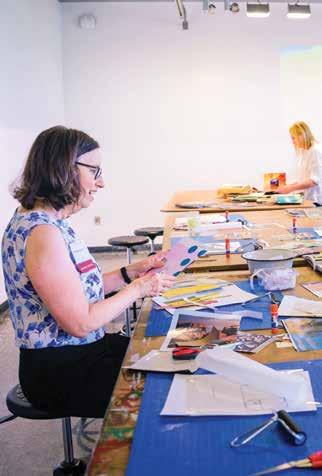
18 Colgate Magazine Summer 2023 scene
Misty Copeland
concert from student a cappella group the Mantiphondrakes; and performances by Scout Gillett and Sarah Shook and the Disarmers at the Palace Theater, presented by the Colgate Live Music Collective.
Student start-ups — and a new vision for the future
Saturday’s events began with a faculty panel discussion featuring arts and innovation faculty members Aaron Gember-Jacobson, Lynn Schwarzer, Margaretha Haughwout, Mary Simonson, and Ryan Chase. Provost and Dean of the Faculty Lesleigh Cushing served as moderator.
The group explained how the deliberate and thoughtful design of the new Benton Center for Creativity and Innovation — at the heart of a new Middle Campus — will help to enhance collaboration across disciplines and encourage curiosity and creativity among students.
“We thought about flow and proximity and points of intersection, where creative encounters can happen organically,” Schwarzer said of the facility, which is currently under construction and expected to open in fall 2024.
Haughwout shared how cutting-edge tools housed in the Benton Center — like a digital loom, a laser printer, and a 3D printer that extrudes only biological materials like paper, pulp, and clay — will allow students to experiment and create in new ways. “I’m
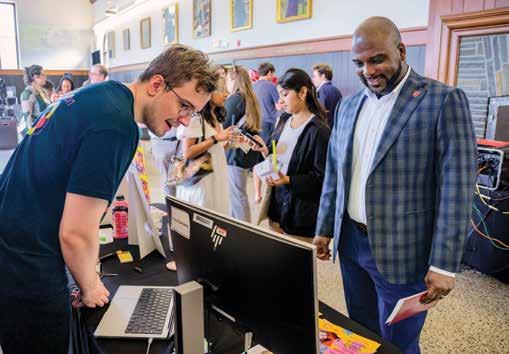
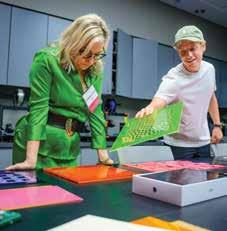
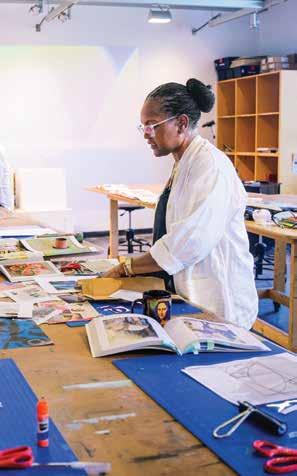
The informal showcase was followed by a panel discussion featuring five alumni entrepreneurs, including Britty O’Connor ’12, MA’13, the 2023 Entrepreneur of the Year award winner and owner of Hamilton’s Flour & Salt Bakery and Martha’s On Madison. The conversation, moderated by Carole Robinson ’83, P’18, chief communications officer at Buzzfeed, focused on the importance of perseverance and flexibility.
“Be OK with hearing no,” advised Justin Polk ’03, co-founder and director of Invisible Collective. “You can’t let it stop you.”
At the Arts Open House, guests explored the Dana Arts Center and the Picker Art Gallery, talking with student docents about the work on display.
excited to think about students working with these tools, which hit a lot of their different interests, from textiles and fashion to the environmental sciences,” she said.
At the Thought Into Action Entrepreneur Showcase, presented by the Office of Entrepreneurship and Innovation, 17 students presented their ventures at booth displays. They competed for investment certificates (called “iggies”) given to attendees, with the instructions to award their dollars to the start-ups most worthy of their investment. A total of $5,000 was awarded, with ventures receiving an amount proportional to the number of iggies they received.
Other events on Saturday included the annual African Student Union fashion show; Akfest 31, the Colgate Resolutions’ spring concert; and a live show from singer-songwriter Ana Egge, also part of the Colgate Live Music Collective.
The creative exchange of thoughts and ideas that transform into ventures and further visions of the way things could be: this is the stuff of Middle Campus and of Colgate’s inaugural Arts, Creativity, and Innovation Weekend. “We have high hopes,” Schwarzer says, “and I think we can’t begin to imagine the possibilities.”
Summer 2023 Colgate Magazine 19 scene
All articles written
by Mary Donofrio
mark
(4)
Students showed off their start-ups during the TIA Entrepreneur Showcase.
diorio
Colgate Commitment
Significant Gift Supports Financial Aid
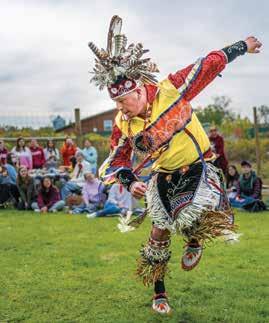
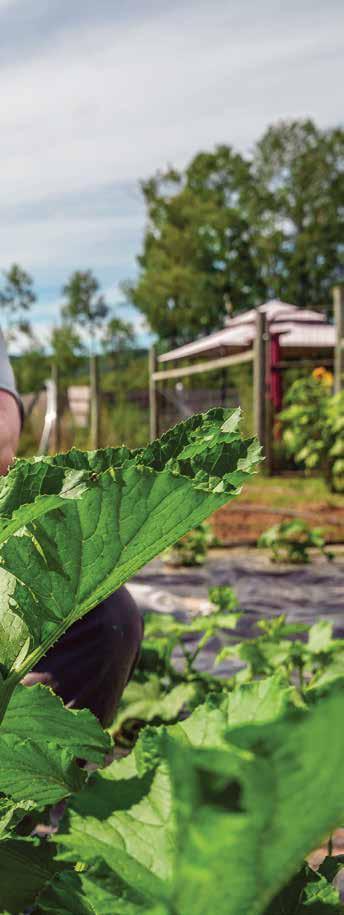
A$20 million gift toward the Colgate Commitment from John K. Hoyns ’76 helped Colgate University crest the halfway point of its $1 billion Campaign for the Third Century goal.
“To put our achievement in perspective, if Colgate were to end its campaign today, this would be among the top-five largest of any liberal arts college,” says President Brian W. Casey. “Far from ending today, however, we are inspired to continue. Our ambition is reaffirmed.”
Launched publicly in April 2022, the Campaign for the Third Century will fund initial priorities within the ThirdCentury Plan, including the Colgate Commitment, Colgate’s long-term financial aid initiative to increase student access and affordability. The $20 million gift is one of the largest ever received among Colgate’s peer institutions in support of financial aid. In recent months, the University has received generous support from alumni, parents, and friends in support of every pillar of the Third-Century Plan: academics; creativity and innovation; faculty; admissions; residential life; athletics; campus and sustainability; diversity, equity, and inclusion; and life after Colgate.
The majority of campaign donors participate through the Colgate Fund, which provides immediate resources for programs across the University. Gifts to the Colgate Fund helped to launch the Colgate Commitment and allow Colgate to enhance student life, support athletics, and improve the physical campus.
Additionally, recent major gifts in support of arts, creativity, and innovation and the Middle Campus, including the Benton Center for Creativity and Innovation, have helped the University advance toward its $1 billion goal.
“Several initiatives in the Third-Century Plan — including the building of Middle Campus and renovation and expansion of Lower Campus — will take years to complete,” says Casey. “But we are relentless in our pursuit of excellence, and we have demonstrated time and again that we are more than capable of such sustained effort.”
20 Colgate Magazine Summer 2023 Scene
mark
(3)
The $20 million gift is one of the largest ever received among Colgate’s peer institutions in support of financial aid.
diorio
Community Garden events teach about Indigenous culture, spirituality, and agriculture.
Sustainability Helping the Garden Grow
Colgate’s Community Garden recently received a total of $105,000 to help fund the addition of a greenhouse. The greenhouse will be open by June 2024 and will help support the Community Garden as both an educational space and source of food for campus and local families.

A $25,000 sustainability grant from the Fred L. Emerson Foundation and an $80,000 pledge from Mark and Julia Schonfeld P’25,’27 will allow the garden to extend its growing season by several months, enabling more time for faculty and student research and increasing the amount of produce to be donated to the Hamilton Food Cupboard. 18' x 20', metalframe greenhouse will be located on a concrete pad on the site and will feature potting benches, growing tables, and the capacity for a future hydroponics system.
Established in June 2010 with seed money from the Class of 2010, the garden has served as a social, research, educational, and food production space, supervised by Garden Manager Beth Roy and tended by student interns, faculty and staff members, and volunteers from campus and the community. The garden features an apiary, production crops, and 12 raised garden beds for use by community members.
Julia Schonfeld, mother to Natalie ’25 and Audrey, an incoming firstyear student, is a board member for Groundwork USA, a national nonprofit organization dedicated to improving the natural environment in marginalized communities. After learning about Colgate’s sustainability initiatives, part of the Third-Century Plan, Julia was introduced to Roy and John Pumilio, director of sustainability.
“I was impressed by everything Beth and John were doing to make the garden a resource not just for students, but for the local community,” says Julia. “I thought the garden would be a nice focus for our gift.”
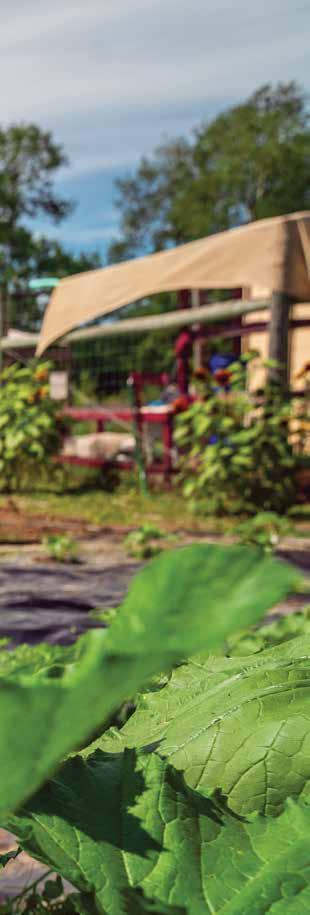
In addition to serving the Hamilton community through its produce, the garden also provides a powerful teaching tool. Students in Professor Chris Henke’s ENST 390 course have partnered with the Community Garden to develop new connections with regional Indigenous communities by planting a Three Sisters Garden last summer and hosting events where students and community members can learn more about Indigenous methods of food production and traditional intersections of culture, spirituality, and agriculture. The garden will continue to host these events in the coming years and serve as a site for growing and saving Indigenous seeds.
The greenhouse project aligns with Colgate’s Third-Century Plan, which prioritizes a sustainable and carbonneutral campus by supporting the University’s commitment to more sustainable food sourcing. Since 2010, the Colgate Community Garden has served as an educational space that provides student interns and campus community members firsthand opportunities to learn about gardening and small-scale agriculture. Its mission is to raise awareness of local food production, sustainable agriculture, and the food cycle on campus and in our community; increase local food options available to students through dining services; and to serve as a place of interaction and positive engagement that further strengthens the bond within the Colgate community and our Hamilton neighbors.
Summer 2023 Colgate Magazine 21 scene
Students sell produce from the garden at a farm stand in the Coop.
Discover
Professor of Economics Derek Jones, and they showed that, if a company introduced employee ownership, employee productivity increased by about 4–5%.
“It’s a very simple idea,” Kato says. “If your pay or wealth is tied to the company performance or the well-being of the company, you’re going to work harder and smarter.” Under a shared-capital system, employees start thinking about how they can improve productivity.
“I’ve been doing this for three decades now, and all the evidence I have acquired so far points to positive or neutral effects, but not negative effects,” he says.
A New Generation of Research
Jason Wang ’23, one of Kato’s students, says he first became interested in shared capitalism after he took Kato’s class The Japanese Economy. Several Kato classes later, Wang is now researching the intersection of economic justice and shared capitalism. Most recently, he has been analyzing unique longitudinal data to provide new evidence on the effect of shared capitalism on wealth for workers with and without disabilities. This effort informed both a labor seminar paper and his honors thesis.
Wang’s findings show that, when shared capitalists become disabled, “they do not lose as much wealth as non–shared capitalists, pointing to shared capitalism as an effective mechanism to help workers with disabilities,” he says.
Wang notes his self-interest in the study of shared capitalism. “Eventually, I’ll be a worker and I want to work in an environment where I can accumulate wealth and where I can be treated fairly,” he says. “I think that’s what I really get from shared capitalism. It’s a program that can benefit all employees.”
Putting Shared Capitalism Into Practice
Sharing the Wealth

Research into employee ownership connects a professor, student, and alumnus
In his more than 30 years of studying shared capitalism, Professor Takao Kato says there is a strong consensus among scholars that an employee-ownership model is most successful when employees have a true voice — not just a financial stake — in company decisions.
Kato, W.S. Schupf Professor in Far Eastern studies and professor of economics, is building on those decades of research by studying the day-to-day work of a Colgate
alumnus while helping to guide a new generation of researchers in exploring the effects of employee ownership.
Kato’s career took a turn in 1995, when he co-published an article in American Economic Review, providing the first rigorous evidence of the positive productivity effects of employee ownership. Kato says that it was the first time people really started to pay attention to his research.
The findings were produced in collaboration with Hamilton College
Daniel Goldstein ’89 lives shared capitalism as president and CEO of Folience, a holding company with more than 500 employees, based in Cedar Rapids, Iowa. He initially reached out to Kato after seeing the professor’s name in the program of the 2020 Kelso workshop at Rutgers, and Kato recently visited Goldstein in Cedar Rapids to further their academic-practitioner collaboration.
Folience was originally established in 1884 and began transitioning to employee ownership in 1986, resulting in 100% employee ownership by 2012. Goldstein joined the company in 2016 and was instrumental in diversifying its business portfolio and transforming its employee ownership culture, embodied in the
22 Colgate Magazine Summer 2023 Illustration
Schmitz
by Stephan
Economics
company’s employee stock ownership plan (ESOP). In 2022, Folience was named the National Employee-Owned Company of the Year by the ESOP Association in recognition of the company’s continued commitment to employee ownership.
ESOPs are governed by some of the same laws and regulations as 401(k) plans. But ESOPs offer additional advantages to businesses, owners, employees, and communities — including increased employee engagement, because employeeowners share the rewards and risks of stock performance.
Also, most ESOPs don’t require an out-ofpocket contribution from employees, and they help to narrow the wealth inequality gap, with ESOP company employees tending to both earn higher wages and greater savings than those in non-ESOP companies — findings supported by decades of Kato’s research.
When it comes to generational transition of ownership in companies, a business will often be handed down to heirs, sold to a private equity company, or end up closing, according to Goldstein. But, through his work on the ESOP Association Board of Directors, he hopes to advocate for shared capitalism and encourage retirement-ready business owners to consider a different option.
“This is absolutely capitalism. It’s not a handout, but a much better path,” Goldstein says.
Sharing the Exploration
Goldstein also notes that broken companies aren’t fixed by employee ownership, and the leadership and employees all have to be educated and engaged for it to be successful.
“Getting your employees to focus on building their retirement is a challenge. It requires a lot of education,” he says.
Kato agrees and says there is a strong consensus among scholars that an employee-ownership model is most successful when combined with other supporting programs.
“It’s vital that employees have an effective mechanism to share their ideas and also that a company makes sure to adequately educate and train employees,” Kato says.
Goldstein continues to be a strong advocate for shared capitalism and ESOPs, testifying before Congress in 2020 about small-business benefits and challenges as part of his ongoing advocacy work. Kato says, as a researcher, his approach is completely neutral, based on statistical analysis: “If the evidence tells me this doesn’t work, then I would say so.”
— Stephanie DeVries
Professor Joel Sommers’ Smithsonian Showcase
Tracing America’s physical internet infrastructure through major cities reveals a pattern that follows roads, rail lines, and pipelines. It uncovers the paths of fiber-optic cables, which connect internet signals between major cities. This figure originally appeared in the research article “InterTubes: A Study of the U.S. Long-haul Fiber-optic Infrastructure,” which was co-authored by Professor of Computer Science Joel Sommers. It is now featured in the Smithsonian National Museum of Natural History’s exhibition titled Cellphone: Unseen Connections.

Sommers’ research maps the long-haul fiber-optic network in the U.S. using data both from major cable and internet service providers and local municipalities to chart how the physical conduits of optical fiber are shared among providers. Further, his research article assesses the implications of the map regarding performance, net neutrality, and policy decision making. Alongside Sommers’ image of the internet’s physical route, the Smithsonian exhibition features objects such as the first commercial cell phone and a display showcasing a few elements and minerals — copper, gold, and lithium — that power our mobile devices. All aspects of the exhibition point to one claim: man-made cell phones and their associated infrastructure bring us closer to one another.
— Tate Fonda ’25
Summer 2023 Colgate Magazine 23
Networks
Location of physical conduits for networks considered in the continental United States
Editor’s note: The map’s visual presentation is intentionally blurred due to security reasons.
A Case of Dubious Provenance
antiquities seized from the Met
At some point in the 1960s, local farmers in southwest Turkey uncovered a stunning group of ancient life-size bronze figures in rocky terrain outside their village, which had once been the site of the Roman city of Bubon. Instead of notifying authorities, as Turkish law requires, the villagers secretly dug out the whole area and sold the finds — statues and fragments dating back to the second century C.E. — to an international art smuggler.
Through the ensuing decades, the looted artworks made their way to dealers on the international market and, eventually, into American museums from Worcester, Mass., to Santa Barbara, Calif. One of the statues, a 6-and-a-half-foot-tall headless
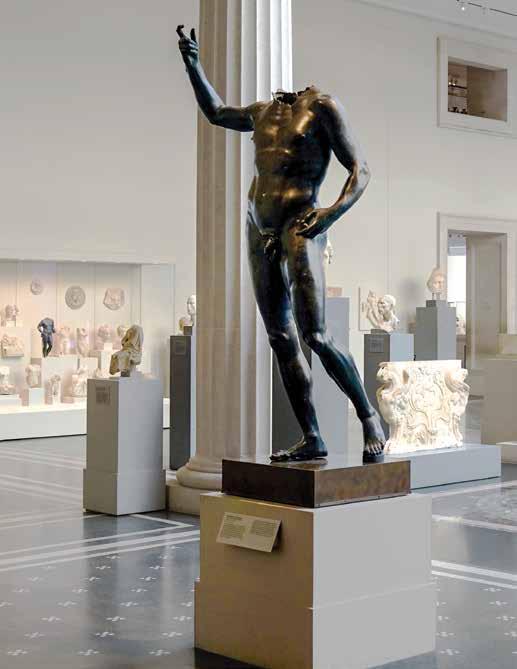
bronze, believed to represent the Roman emperor Septimius Severus, was loaned by an anonymous collector to New York City’s Metropolitan Museum of Art in 2011. Last February, the statue was one of three objects seized from the museum following a criminal investigation by the Antiquities Trafficking Unit of the Manhattan District Attorney’s Office. In a press release, the office credits Elizabeth Marlowe, associate professor of art and art history, with “investigative support” leading to the seizure.
Marlowe, an expert in ancient art, has long argued that an artwork’s historical grounding — that is, information about its original source and context — is essential to our understanding of it. In September
2022, she published an essay in the online art journal Hyperallergic in which she pointed to the Bubon group as an egregious example of the practice of vague or deceptive labeling of artworks by museums — something that scholars, dealers, and museum professionals are aware of but rarely acknowledge. (The practice is commonly used in cases of dubious provenance, such as Nazi-looted artworks or works plundered by colonial forces.) Despite the strong likelihood that the Met’s figure was one of those stolen from Bubon — due to the details of its ownership history and its similarity to the one remaining statue at the site, among other signs — the gallery label was conspicuously vague, identifying it as “Greek or Roman, Hellenistic or Imperial.”
“The strategy with labels for this group has been to pretend that ‘Some people think this might be from Bubon, but we don’t really know, there’s no hard evidence,’” she says. “But the reason there’s no hard evidence is because the smugglers covered their tracks. We know these were looted from somewhere, and the circumstantial evidence all points to Bubon.”
Over the years, Marlowe became increasingly distressed by the fact that, although art historians have long known what she calls the “awful backstory” of Bubon, it has not been openly recognized or written about, let alone included in textbooks.
“It was time to be a little braver,” she says. Marlowe visited several of the museums where the Bubon pieces are on display and documented what the labels said about their “findspots.” In her piece, she explains that “some U.S. museums value the retention and growth of their collections to the near exclusion of all other concerns,” equating the Met’s disingenuous labeling to a “laundering operation” that “betrays the museum’s scientific and educational mission.” But she calls out the other museums whose collections contain Bubon artifacts, as well.
“I wanted to show this is systemic. All of these institutions have this problem. That means we all need to work on it together,” she says.
Indeed, Marlowe believes museums must share — with each other and the public — the truth about the items in their collections, even if it means the country of origin ends up asking the museum to give some pieces back.
And that is exactly what happened in the case of the Septimius Severus statue. According to Marlowe, her Hyperallergic article had the effect of renewing interest in the Bubon statues among Turkish
24 Colgate Magazine Summer 2023 discover
Art
Professor Elizabeth Marlowe offers investigative support for looted
Steven zucker, smarthistory
Bronze statue that was one of three objects seized from the Metropolitan Museum of Art last February
cultural authorities, and they turned to the Manhattan DA’s office, which, along with Homeland Security Investigations and the Turkish Ministry of Culture and Tourism, was already conducting a criminal investigation into several illegally obtained antiquities. Shortly after the prosecutors seized the bronze statue of Septimius Severus, plus two other heads from the Bubon group — one at the Met and another from the Museum of Greek, Etruscan, and Roman Art at Fordham University — the objects were returned to Turkey in a repatriation ceremony.
More and more, scholars, the public, and even politicians are questioning the acceptability of museums possessing what amounts to stolen goods. In 2017 for example, French President Emmanuel Macron pledged to return artifacts that were acquired as a result of France’s colonial presence in Africa to their places of origin. Other European countries soon followed suit.
Marlowe, who acknowledges that scholars in Native American studies and anthropology were grappling with questions of problematic provenance long before art historians, says that her students are much more attuned to issues of decolonization and cultural heritage than she was as an undergraduate. Six years ago, she helped to found Colgate’s interdisciplinary Museum Studies Program so students could explore these questions and more through courses in art history, anthropology, history, and other disciplines.
For all her criticism of duplicitous museum practices, Marlowe stresses that she is not anti-museum. “Museums should be places where we go to learn about and celebrate other cultures,” she says. “The idea that the artwork is there despite the vociferous objections of the people to whom it actually belongs, or simply without the consent of the community from which it originates — I don’t want that to be what museums represent.”
Those who oppose returning works of cultural heritage to their source often deploy the “slippery slope” argument, contending that museums will end up as empty shells. Marlowe disagrees, pointing out that “most countries are thoughtful about which pieces are meaningful to their living culture,” and none is asking that every stolen item be returned. Rather, she envisions a sort of reverse slippery slope: “I hope that being repositories of unethically acquired things will seem intolerable to museums,” she says. “That would be a shift in their moral paradigm.”
— Sarah C. Baldwin
Jazz, John Coltrane, and Crooning
Professor Michael Coyle’s interest in jazz music led him to question one peculiar record, which made waves in the history of Black music.
azz legend John Coltrane made only one record with a vocalist Johnny Hartman, a crooner who hadn’t yet found success when the album was released in 1963. Why would Coltrane choose Hartman, a crooner, over a jazz singer? This is the question Professor of English Michael Coyle addressed in an essay that will be published in Cambridge University Press’ forthcoming Companion to Jazz and Modernism.
Coyle’s interest in music dates back to his childhood, when he discovered his love for rock music. From there, he began to explore earlier genres, such as jazz. Coyle refers to himself as a “modernist scholar” — he’s interested in the emergence of modern rhythms both in music and in poetry.
Coyle started researching the ColtraneHartman collaboration when a performer he brought to a Core Challenges of Modernity presentation adapted the record. It was then that he noticed the stark difference John Coltrane and Johnny Hartman presented against Coltrane’s other records. Coyle began to delve into the history of crooning, a style made possible only after the commercial availability of the microphone in 1927. Before microphones, the predominant singing style was shouting — a skill mastered by loud performers such as opera singers — and it allowed them to project their voices without the help of technology.
“There was, for instance, in 1930s Kansas City, a guy named Big Joe Turner [who] learned to sing in crowded Prohibition-era ballrooms in Kansas City,” says Coyle. “His voice was so big, that at a certain point, the guy on stage would give him a signal and he’d
start singing from behind the bar; his voice could fill the room.”
With the introduction of the microphone, the Big Joe Turners of the music scene fell out of style; many performers stopped belting and began to sing softly. Audiences grew keen to soft-voiced performers, such as Rudy Vallée, because these performers could express a wide range of gentler emotions.
Vallée’s soft music achieved dramatic highs and subtle lows. His innovative crooning style inspired household names such as Bing Crosby, who also achieved astounding success.
“The first crooners,” Coyle says, “had an electrifying effect on the nation.”
Crooning, which was pioneered by white performers such as Vallée and Crosby, was then adapted by Black musicians. This is where its history gets interesting. The ability of Black performers to record their work and adapt the recordings of others led to quick, mass innovation.
“Crooning is possibly the only 20thcentury American style that was developed first by white performers before being adopted and adapted by Black performers,” says Coyle. “So there’s this pause in time before crooning gets taken up by Black performers. To them, crooning has always represented modernity — a refusal to allow other people to tell them what it means to be Black.”
This was when Coltrane put out his version of a crooning record featuring Hartman — who cemented his legacy with this record, filling its long tracks with slow, swirling melodies. Whereas Vallée crooned rhythmically, rushing to the next word, Hartman crooned patiently, expanding the style.
“Lots of people who don’t like John Coltrane because he’s not melodic enough love this record, because it’s just beautiful,” says Coyle.
Altogether, John Coltrane and Johnny Hartman was unlike any record that Coltrane had made. So why did he make a crooning record anyway?

“There were a lot of reasons,” says Coyle. “Coltrane’s music was so radical at that point that white jazz critics were attacking him as being anti-jazz. So he was under pressure from his manager to make a traditionalsounding record.”
The choice of whom to feature on vocals was then entirely Coltrane’s. It came as a surprise that Hartman, a crooner who was unknown on the mainstream scene, was chosen. Coyle and audiences agree with the choice.
“It’s gentle and it’s lyrical. You think, ‘How does anybody sing that way?’ It’s just perfect.”
— Tate Fonda ’25
Summer 2023 Colgate Magazine 25 discover
J
Music
Philippe Gras (Coltrane); Everett Collection Inc (hartman)
/
Alamy Stock Photo

26 Colgate Magazine Summer 2023
New and historic buildings form residential quadrangles on West Row.
A Broad View:
Investing in Student Life and Our Residential Tradition
Colgate University is rebuilding and renovating housing for its juniors and seniors, creating a new campus region, the Lower Campus.
 By MARK WALDEN
By MARK WALDEN
Summer 2023 Colgate Magazine 27
At Colgate, the academic quadrangle is our village green — grassy, shaded, and bordered by buildings that belong on postcards. The Middle Campus is on its way to becoming an arts, creativity, and innovation district. The west side of Broad Street, at the south entrance to the campus, will continue to be the home of Colgate athletics, with its arenas, fields, and training centers.
Meanwhile, different forms of housing, in various states of repair, dot College and Broad streets. In spite of their proximity to campus, they can seem disorganized, distinct, and distant from Colgate’s physical core. Through a massive, multiyear investment in student life, the University is about to create a new campus neighborhood there. It is called the Lower Campus, and it stretches from Phi Delta Theta to the south, past Bunche House and the Loj, toward Kappa Kappa Gamma on the northern edge.
Once this ambitious set of ThirdCentury priorities is realized, all first- and second-year students will join a completed Residential Commons system atop the Hill. As juniors and seniors, they will move into Lower Campus theme houses, fraternity houses, sorority houses, apartments, and townhouses. They will certainly sleep in these spaces, but they will also form friendships, collaborate, socialize, cooperate, eat together, and continue to build on the knowledge they gained in the classroom.
This kind of community is available to a portion of the student body today. New buildings and renovations will make it universal as Colgate doubles down on its commitment to residential life within its liberal arts tradition.
The Big Picture
In the early 2000s, Colgate purchased the fraternity and sorority houses along Broad Street. These chapter houses joined theme houses, such as the Loj and Creative Arts House, on the list of living options for juniors and seniors. A comprehensive review of Broad Street housing in 2006 identified these buildings’ extensive renovation needs, but work paused for leadership transitions and subsequent strategic planning. Deferred maintenance mounted. President Brian W. Casey arrived
28 Colgate Magazine Summer 2023
We will always engage in longterm planning, seeking sustained change. It is so easy to do quick things, but we will take the longer-term view.”
President Brian W. Casey
in 2016 and wanted to take a look at this neighborhood as the long-term strategic plan for the University emerged. Why not think of the area holistically, rather than as 17 individual renovation projects? The neighborhood — including the addition of a new West Row of housing, to be located behind the traditional houses along Broad Street — would become a place where more Colgate students could live together in community.
The Lower Campus became the subject of close study by some of the nation’s leading architecture and landscape experts as well as the New York State Department of Environmental Conservation and the U.S. Army Corps of Engineers. These planning efforts led to a comprehensive physical plan for the Lower Campus, showing Broad Street as it is and how it could be. Old Broad Street is still there. You can see it in 76 Broad, Delta Upsilon, Bunche House, and Gamma Phi Beta or “Little Blue.” But so is the collective potential of structures that, together, will house more than 1,000 Colgate juniors and seniors in a way that simultaneously promotes community and a sense of a campus.
“For upper-level students, Colgate will create a distinctive and cohesive residential experience that is a developmentally appropriate extension of their first two years living on the campus,” says Vice President and Dean of the College Paul J. McLoughlin II.
A Walking Tour
Let’s start at 66 Broad Street (the chapter house of Delta Upsilon, or Porter House, depending on your graduation year), because that’s what the University itself is doing. Students who would normally live in this house will be relocated to other spaces for a year, and construction crews will walk the hallways instead, removing everything in their path, down to the wall studs.
“This is not just deferred maintenance,” says McLoughlin. “This is a complete renovation, an opportunity to reimagine these spaces for the ways in which students live and learn in the 21st century. Careful attention will be paid to preserve house attributes and architectural history, while readying these houses for the next generation of students who will occupy them.”
Workers will rebuild the interior of 66 Broad Street and do the same next door at 70 Broad Street, current site of the Loj. By then, architects will be submitting schematic designs for West Row’s townhouses, social center, and two stand-alone reading rooms — to be known as studies. New buildings and historic structures will, together, form a series of residential quadrangles.
The University intends to advance down Broad Street, renovating one to two houses at a time and building new residences behind them until construction crews reach an expanded Payne Creek,

with its new green space and footbridge. Attention will then focus on the existing stock of apartments. By that time, the University will have created or restored dozens of architecturally cohesive homes and built new social and academic spaces, where Lower Campus residents can gather regardless of their street address or group affiliation.
The exact order in which renovations take place after the DU chapter house and the Loj special interest house has yet to be determined, and the full Lower Campus plan will take more than a decade to implement in full. But that’s nothing when compared to the century-plus it took to build every structure currently standing on this stretch of tree-lined street. Incremental benefits will appear immediately for the students who live, learn, socialize, and become more connected in these new residential, dining, social, and outdoor spaces.
‘Commons’ Sense
Colgate’s reimagining of the Lower Campus depends heavily on another initiative within the Third-Century Plan: the completion of the Residential Commons system up the Hill. Currently, new students are assigned to one of four Residential Commons, each associated with a cluster of residence halls.
While the majority of first-year and sophomore students live on or alongside the residential quad atop the Hill, hundreds
Summer 2023 Colgate Magazine 29
The social center, a focal point of the reimagined Lower Campus
more live at 113 Broad Street (associated with Hancock Commons). Others still live in Gate House (associated with Brown Commons), originally built as temporary housing more than 20 years ago.
Enter Bob Fox ’59. Last October, before the public launch of the Campaign for the Third Century, Colgate announced that the former head of Revlon International and Del Monte will give $10
million to place Fox Hall adjacent to Colgate’s longest-standing temporary building. The new residence hall will become the first in a complex housing a fifth commons, which will unite with Ciccone, Brown, Dart Colegrove, and Hancock commons in providing welcoming, faculty- and staffdirected communities for the University’s newest undergraduates. Once Fox Hall is completed, Gate House will be removed, and additional residences will rise to complete the fifth commons, with its social spaces and quadrangle overlooking Seven Oaks Golf Course and the valley below.
When Fox himself arrived on campus
in 1955, that bit of real estate was just a stand of trees, one bad pull hook off the old golf course fairway. The son of German immigrants, Fox spent his mid-teens working at a soft-drink bottling company, supporting his family after his father’s early death. Grades, test scores, and his potential as a collegiate swimmer landed him a place at Colgate. He scraped together tuition payments from a combination of sources. “Part of it was financial aid. Part of it was loans. Part of it was just working for room and board,” Fox says.
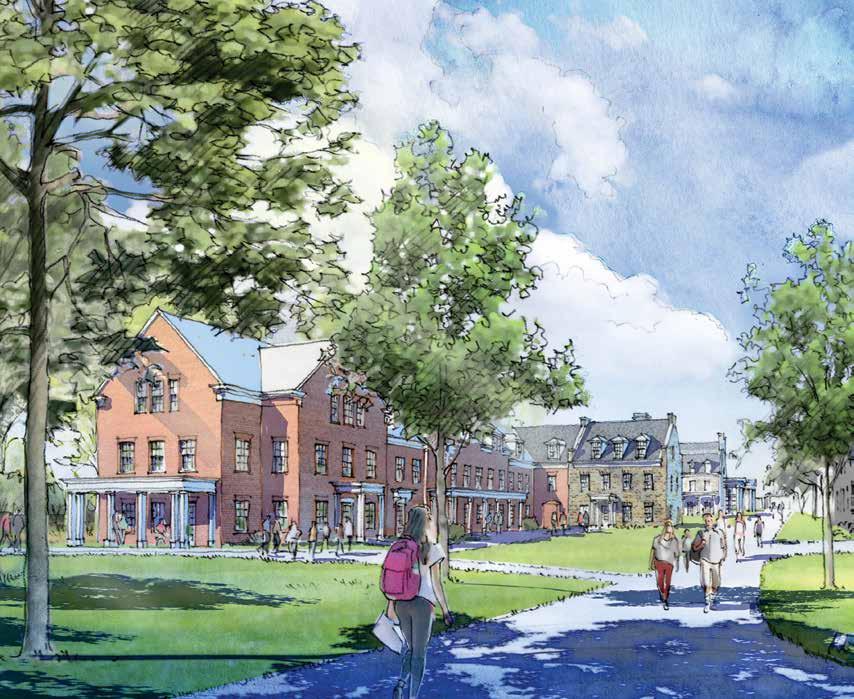
He went on to head leading brands and serve on the University’s Board of
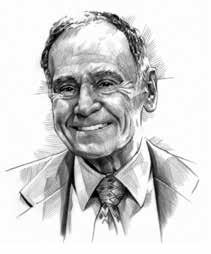
30 Colgate Magazine Summer 2023
BRUCE MORSEr ’76 (FOX)
A view of the Lower Campus walk
Trustees, and through the years, Fox has systematically invested tens of millions of dollars in the foundational elements of his Colgate experience: financial aid; an endowed coaching position for swimming and diving; a Career Services partnership to teach leadership skills; and, now, residential life. In the end, he says, “I wanted to have something that would endure.”
The physical manifestation of Fox’s gift will be stationary. But its implications will spread. The completion of Fox Hall and the commons system means that all first- and second-year students will reside on top of the Hill. The residence hall at 113 Broad
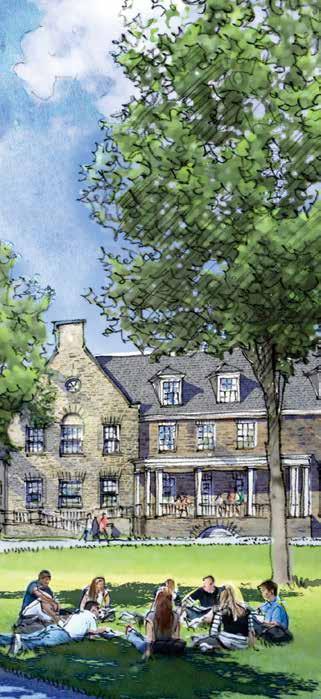
Street will be taken down, and the five commons will be right-sized to maximize interaction among their first- and secondyear members. All juniors and seniors will then be able to live on Lower Campus, where social and residential spaces will be of equitable quality and quantity, thanks to the construction and renovation work that begins at 66 and 70 Broad Street in the summer of 2024.
“The Third-Century Plan makes it possible to redefine Broad Street, opening the community to a more equitable experience — in social space, living space, and dining space,” McLoughlin says. “And as students
move from up the Hill to down it, they will feel that sense of community while building greater levels of self-reliance that they need to transition into life after Colgate. This vision, once realized, will make Colgate’s residential experience even more distinctive than it is today.”
→ 17 Houses
→ Totaling 200,000+ square feet
→ Built between 1845 and 1968
→ Housing 477 students
→ 12–49 students per house
Summer 2023 Colgate Magazine 31
This is a complete renovation, an opportunity to reimagine these spaces for the way in which students live and learn in the 21st century.”
Vice President and Dean of the College
Paul J. McLoughlin II
Broad Street Housing by the Numbers Today
U.S. CONGRESSWOMAN MARY GAY SCANLON ’80 IS NOT AFRAID TO SPEAK UP.
She never wanted to go into politics — but when she made up her mind to do so, Scanlon became a congresswoman fighting for the underrepresented in her district and nationally.
In a matter of just 10 days in January 2018, Mary Gay Scanlon ’80 went from believing “I’d have to be crazy” to run for Congress to “I think I’m going to do this.”
Two news-breaking events affecting Pennsylvania’s 7th congressional district had Scanlon and others in her Swarthmore area wondering what was going to happen with their representation.
First, the New York Times released an article about GOP Rep. Patrick Meehan being involved in a sexual harassment scandal with a former aide (he would resign in April of that year).
By Aleta Mayne
A couple of days later, the State Supreme Court ruled Pennsylvania’s congressional district map to be a partisan gerrymander violating the state’s constitution.
Scanlon’s acquaintances told her: “You should run.”
“It was probably because I’d been complaining [so much] about the state of politics at the time,” she explains.
Because of policies passed during the Trump administration, the voting rights and immigration issues Scanlon had been focusing on as a national pro bono attorney “were suddenly under fire,” she says. “The first weekend he was in office, he signed
the orders involving the Muslim ban, so we were organizing lawyers to go to airports and help people who had landed. We were training people to represent folks who were suddenly subject to deportation and hadn’t been previously.”
Her firm, Ballard Spahr, had also been working on the Obama Administration Clemency Initiative to address mass incarceration.
“The change in administration meant a radical change in policy,” she explains, “with a number of threats to issues I was interested in and in ways that really impacted the people who got caught in the middle.”
32 Colgate Magazine Summer 2023
andr é CHUNG

Summer 2023 Colgate Magazine 33
BEYOND THE BIO SHEET
→ At Colgate: history major, worked on the Maroon-News, and also had a WRCU show on which she read the AP wire
→ Her name is short for Mary Gaynor, after her grandmother’s last name. All of the women in Scanlon’s family have a version of “Mary” in their name — including her two sisters, Elizabeth Maura ’83 and Mary Kathleen. “So Mary Gay became a way to differentiate [me],” she says.
→ Scanlon is often spotted wearing her signature color of royal blue. “It’s turned out, people look for it,” she says.
→ Colgate connections, to name a few: She has contributed to political science classes taught by James Snyder ’80, a fellow history major who now teaches at Le Moyne College. Although former Colgate President Rebecca Chopp was not at Colgate when Scanlon was a student, they connected as neighbors and at church when Chopp was president of Swarthmore College. Scanlon has known Men’s Basketball Head Coach Matt Langel since he was a toddler because “his dad was in the same law firm as me and my husband.”
Another factor motivating Scanlon to run for Congress was that there were 18 Pennsylvania congressmen and two male senators, but there hadn’t been a woman in the state’s delegation since 2014. Scanlon had been participating in a group called Represent PA to raise money to elect more women to the state legislature. “I had an interest in women being in office, in positions of decision-making,” she says.
Scanlon had gained national experience working on issues through her pro bono work; locally, she’d been an election judge and worked at the Education Law Center in Pennsylvania for a decade. “I’d represented families in every school district, so I had a lot of ties throughout the region.”
She further demonstrated her commitment to education when she ran for her local school board. Similar to her later decision to campaign for Congress, Scanlon chose to become involved in the school board because she saw problems that needed to be fixed. She served two terms, as vice president and president, until the youngest of her three children graduated. “That was an appropriate time for other people to have their turn,” she says.
Although Scanlon asserts she “never wanted to go into politics,” she did know early on that she wanted to go into law. Her maternal grandfather, Leo Yehle, was a family court judge, and her father, Daniel Scanlon Jr. ’54, was an attorney who became a federal magistrate judge in Watertown, N.Y., where Mary Gay grew up. “The smalltown practice my father had was appealing to me because he was problem solving for individuals, which was definitely the way I gravitated in my legal career doing public interest work,” she says.
Her role as an attorney provided Scanlon with political awareness, and her school board election gave her a sense of what it’s like to run for office.
In February 2018, the Pennsylvania Supreme Court released a redistricted map; a primary election was scheduled for May 15. “It was a very compressed time frame,” Scanlon says. “But eventually things fell into place.”
Ten candidates ran in the Democratic primary for the new District 5, and Scanlon won with 28.4% of the vote.
“It happened fast,” notes Donald Wilson ’79, who has traveled in similar circles as
Scanlon both on Colgate’s hill and Capitol Hill. “She went from adroit civic and legal leadership, to a Democratic primary of 10 — many with far more political experience — to earning a tough district’s support [as well as] the key endorsement of the Philadelphia Inquirer and revered leaders, to winning.”
Then in November, she beat the Republican candidate and became one of four women who would represent Pennsylvania in Congress beginning in January 2019. It was the largest number of women the state had elected to federal office, and it occurred when a record number of women (103) across the country were elected to the House of Representatives. Now Scanlon is in her third full term representing Pennsylvania’s 5th district, which includes Delaware County, the southern corner of Philadelphia, and part of Montgomery County.
Colgate Magazine spent time with the congresswoman this past spring, when she had recently returned from a delegation trip to Ireland with President Joe Biden, voted on House Speaker Kevin McCarthy’s debt limit bill, and was facilitating a roundtable with local nonprofits as they faced the expiration of pandemic emergency funds that had boosted SNAP (the Supplemental Nutrition Assistance Program).
Tell us about your work around food insecurity and what was discussed at the recent roundtable you led.
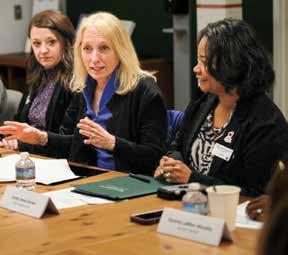
“Philadelphia is one of the poorest large cities in the U.S. It’s not [just] food insecurity; we have huge hunger issues. The topic actively is that a lot of the pandemic food relief expired [at the end of February], so what do we need to do? But it’s also ringing the alarm with respect to the cuts that are being proposed in D.C. — because 20% off already inadequate funding for programs like SNAP, early childhood education, or housing assistance is not good, so I’m trying to get a handle on what people are seeing right now.
“We saw the programs that, as everybody around the table said, made a difference and gave people the breathing room to get the medical care they needed or to have housing or have enough money to pay for childcare so they could go to a job. So it’s a struggle right now to maintain those kinds of benefits, to allow people to put themselves and their
34 Colgate Magazine Summer 2023
mark diorio
“ The change in administration meant a radical change in policy, with a number of threats to issues I was interested in.”
Scanlon leading a roundtable about food insecurity with nonprofits in the Philadelphia area.
families in a better place. We have a situation where, for example, the expanded child tax credit worked. We raised kids out of poverty, we made them healthier, we allowed them to participate in school in a better way — which eventually is going to result in people being able to hold down jobs and pay social security taxes and support current generations. I truly believe that the rising tide can lift all boats. So I try to figure out ways to make those arguments across different sectors.
“The House Committee on Rules [of which Scanlon is a member] has been conducting a series of hearings around the issue of hunger with the goal of having a White House task force to try to update how we handle the issue. [Ranking member Jim McGovern] came here, and we did a tour in this region — trying to make sure we understand what’s happening, where the gaps are, and where we can try to fill those gaps.”
In addition to the House Committee on Rules, you’re a member of the House Judiciary Committee?
“Yes, I knew I wanted to be on the judiciary committee because so many of the issues I’ve worked on — voting rights, gun safety, criminal justice reform, and reproductive rights — are all part of the committee’s work. Because of my public interest background, I found that I am working on the same issues but in a different forum.”
What are some other issues you’ve been working on as congresswoman?
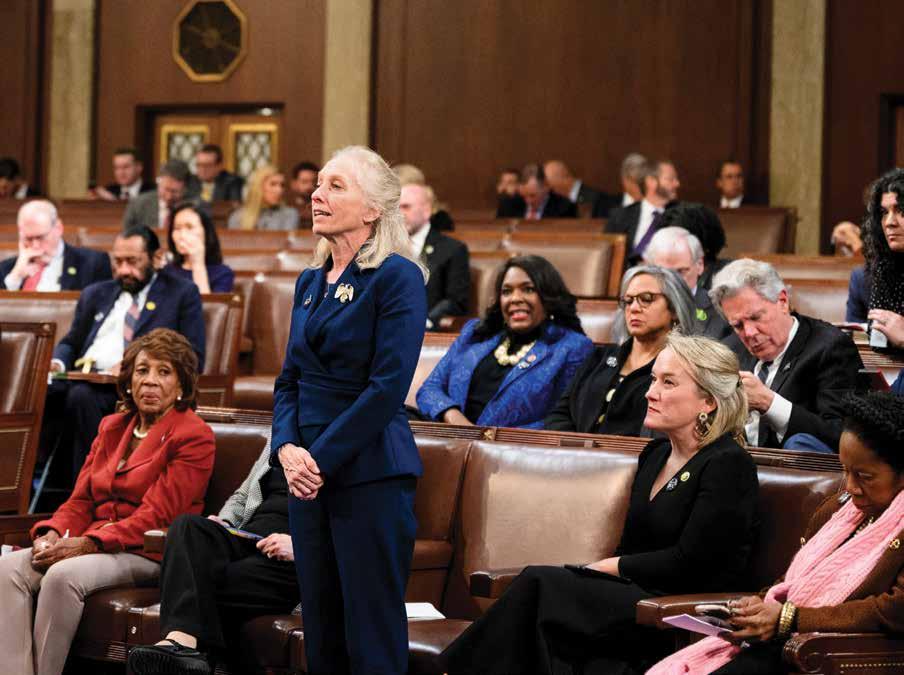
“We have a Congressional Youth Cabinet, which is 11th and 12th graders from across the district. We talk about the issues they’re interested in, what’s going on in Congress, and bring in experts. Recently we brought in someone from CeaseFirePA, the nonpartisan gun safety group. The next day was the Nashville shooting. So I sent
the Youth Cabinet a note and said, ‘If you had a minute to talk to Congress, what would you say?’ They sent me amazing, heartbreaking things. I just took their words in to [Congress].”
What are some accomplishments you’ve been most proud of since you’ve been elected?
“In terms of concrete outcomes, when I was sworn in, in 2019, the Philadelphia Navy Yard was out of contracts. They’d had something like 1,800 people working there, and they were down to a skeleton staff of 60. So one of the first meetings I had was with the boilermakers in a trailer down on the waterfront. People were at the end of their rope because they got laid off, their health coverage was expiring, families were in distress. But I’ve gotten contracts in there for a series of multi-mission maritime training vessels, so we have contracts now
Summer 2023 Colgate Magazine 35
“ Because of my public interest background, I found that I am working on the same issues but in a different forum.”
“ I try to figure out ways to make those arguments across different sectors.”
Eric Connolly
“ I had an interest in women being in office, in positions of decision-making.”
Members of the 118th Congress were sworn in on Jan. 6, 2023.

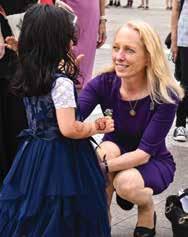
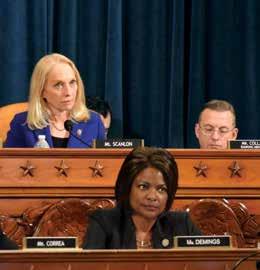
36 Colgate Magazine Summer 2023
“ I truly believe that the rising tide can lift all boats.”
“ Everybody’s coming with different skills, including how they approach Congress.”
“ I am also really proud of our work to engage students and the next generation of leaders.”
andr
é CHUNG (center); Ike Hayman (above)
The impeachment inquiry into President Donald J. Trump
through 2027, both to build new ships and to do repairs on existing Navy equipment. We’re developing pre-apprenticeship and apprenticeship programs, so there’s this way now for people to get really good jobs. They’re rehiring some people and then developing jobs for the next generation, so they’re back up to around 1,500 employees at the shipyard.
“I am also really proud of our work to engage students and the next generation of leaders. I love interacting with our youth cohort and hearing what they think are the most important issues. It is especially rewarding to see the young women and girls consider the ways they can lead in their futures, including running for office.”
Which Colgate professors had an influence on you?
“Marilyn Thie [philosophy and religion and women’s studies] was wonderful. One of the papers I did at the time was to take the philosophers we were studying and apply them to a current issue. That was fun. [She asked us to write about] the current issue [of] how Colgate’s fraternity system needed to adapt to the college’s admission of women.
“Stan Brubaker, political science — his constitutional law class got me through my UPenn constitutional law class. I used the notes. Thank God for him. I called him a couple of years ago and told him that.
“Jack Rakove, who’s now an endowed history professor at Stanford. He’s written Pulitzer Prize–winning books about the constitution — his area of American history is constitutional interpretation. I’ve actually been in touch with him when I had constitutional questions the last few years. He knows that era and the writings of the founders better than probably anyone.”
What is it like working in Congress today?
“One of the things I love is that it’s 435 very different people with very different styles — I came in one of the biggest classes. We’ve got Lauren Underwood (IL-14), who’s a public health expert and started the Black Maternal Health Congress. That’s someone whom I can go to who really knows the issue inside out. Also, some of my colleagues are involved in clean energy; they’re going to take the lead on those things. Everybody’s coming with different skills, including how they approach Congress. There are the work horses and show ponies. I think of myself as one of the work horses.”
What keeps you up at night?
“Representing three quarters of a million people. There’s always something you can be doing.”
INSIDER INFO
We asked two alumni who have had a longtime connection to Scanlon to sum up her character in just one word. Both needed three:
“Force of nature,” is how Todd Estabrook ’81 describes Scanlon, who has been his best friend since they grew up together in upstate New York. “When she gets involved in something, she sees it straight through to the end. Her energy is infectious, and that pulls everybody up along with her.”
Scanlon even brought Estabrook to Colgate. He visited her in Hamilton when she was a first-year and thought, “I definitely have to go there.” They’re close in age (she’s actually five weeks younger), but Scanlon was a year ahead of him in school because she skipped first grade. “And that’s pretty much Mary Gay,” he says, “she was ahead of the rest of our crew always.”
Seeing his longtime friend rise to the ranks of a congresswoman, Estabrook says, “I admire her so much. Her emotional quotient is just as high as her IQ. She reads people well, and she’s a good human being. She cares about the issues important to her constituents but also sees the larger national picture and how we have responsibility to care for everyone in the country — and she promotes policies that do that.”
Donald Wilson ’79 calls Scanlon “grace under pressure.” He adds: “You hear it in her voice: calm, tolerant, but truth telling with diplomatic power.” Wilson, who has worked with leaders and politicians nationally, reached out to her when she decided to run for Congress because he believed “she had extraordinary experience to offer.” They’ve kept in touch over the years, and Wilson has been supportive of “her great efforts, which are formidable.” For example, he says, Scanlon was elected vice chair of the House Judiciary Committee as a freshman, and she helped draft the language when it had to consider two articles of impeachment against President Donald Trump. “When there were tough [media] interviews to be done, up she stood, more than ready, and delivered difficult news to a nation hungry to hear reason and right thinking,” Wilson says.
Noting that she “has an intensely difficult job at one of our history’s most difficult hours, Wilson says that Scanlon has had genuine poise. “Emerson wrote that the true test of heroism is its persistence. Mary Gay Scanlon is persistent in a glowing, empowering, inspirational way.”

Summer 2023 Colgate Magazine 37
“ I admire her so much. Her emotional quotient is just as high as her IQ.”
mark diorio
Todd Estabrook ’81

My Colgate research motivated me to become:
• A STATE ARCHAEOLOGIST
• A REAL ESTATE INVESTMENT RESEARCHER
• A COLLEGE PREP COUNSELOR
• AN EPA ECOLOGIST
• A U.S. GEOLOGICAL SURVEY SCIENTIST



• AN IMMIGRATION POLICY CHANGEMAKER
• THE LEAD SCIENTIST ON A DRUG DISCOVERY TEAM
• A CHEMIST WORKING ON GOVERNMENT CONTRACTS
• A MEDICAL COMMUNICATIONS SPECIALIST
• AN NIH SENIOR INVESTIGATOR
In the fall of 1994, Dixie Henry ’96 was sifting through dirt at an excavation site near campus for her first day in the field as part of Professor Jordan Kerber’s Field Methods and Interpretation in Archaeology course. The group didn’t find much on that day’s dig, she says — maybe a few lithic flakes (“the bits and pieces that come off stone tools”) — but
BY ALETA MAYNE
Henry was captivated by the way Kerber presented this exploration of the past. “I was hooked,” she says. When she hopped off the group’s van at the end of the day, Henry ran all the way to the fraternity house where her boyfriend (now husband), Steven Kopecky ’96, lived and burst into his room, declaring: “I am going to do archaeology for the rest of my life.”
Henry kept her word. She’s now a state archaeologist and preservation officer for the Maryland Historical Trust.
Before that defining moment, another anthropology professor, Gary Urton, had noticed Henry’s budding interests and asked if she wanted to be his research assistant. Her job was to compile an inventory of the Longyear Museum’s Iroquois materials,

Summer 2023 Colgate Magazine 39
Illustrations by Dana Smith
in accordance with the Native American Graves Protection and Repatriation Act. Most of the items were recovered from sites in the ’50s and ’60s, Henry says, and the University repatriated many of them to the Oneida Indian Nation in 1995. “The research that went into that, the back and forth with the Oneida Indian Nation, and the actual day of watching them accept [the items] back and explaining to me what was going to happen with them was really influential,” she remembers. “It made a huge impression on me and led me to start asking questions about the ethics of archaeology: How has it been done in the past, how should it be done in the future, what are the responsibilities of the archaeologists, and what are the concerns of Native communities?” This work would later become the basis of her senior thesis on repatriation.
During the summers of her junior and senior years, Henry participated in Kerber’s Oneida Indian Nation Archaeology
Workshop, collaborating with the Nation to teach their youth field methods and lab procedures. “They were excavating sites that had been occupied by their ancestors, and that was really important to them,” Henry says. The group was accompanied by elders who would walk around the site and remind the youth, “This is your history, this is your heritage.” Henry says: “I was in awe, watching this relationship, and thought, ‘This is how we do it better. This is how we work together to protect these resources.’”
All of these experiences began to build a foundation for Henry. Then when she went on the Santa Fe Study Group led by Kerber and Professor Mary Moran, Henry met a New Mexico state archaeologist (who was also an instructor for the study group). “He was the one who introduced me to the ideas of public archaeology and cultural resources management,” she says.
Majoring in sociology and anthropology as well as Native American studies, Henry
went on to earn her PhD at Cornell. At the same time, she was a TA for Kerber’s field methods class, and in the summers, she was an assistant field director. She supervised excavations and participated in consultations with the Oneida Nation’s Men’s Council regarding the treatment of the sites, the methodologies, and procedures to be followed.
After graduating from Cornell, Henry joined the government of Maryland on the state’s Commission on Indian Affairs, where she was responsible for promoting public awareness of American Indian history and culture. “My professors at Colgate encouraged me to never lose sight of our responsibility to craft the field of archaeology into a discipline that is more inclusive, more collaborative, and more relevant to its multiple constituencies,” she says. “That has stuck with me this entire time.”
In 2003, she became an archaeologist in the Project Review and Compliance unit at the Maryland Historical Trust, where she reviews state and federal projects that may have an impact on historic properties, in accordance with the National Historic Preservation Act.
On her office bulletin board, she’s pinned a Syracuse Herald American article from 1994 in which she’s pictured smiling and looking at a piece of pottery in her field methods class. “I keep it there to remind me of the joy I was feeling at that moment and to remind me of where I’ve come from and who helped me pursue my dream.”
If You Lived Here, You’d Be Home by Now
Train or automobile? That was the question Jacob Anderson ’07 pondered during his internships following his junior and senior years. One involved taking the train into Chicago for his work at a telecommunications company, and the other required driving into Boston to work for a real estate developer. “I was driving maybe a mile or so, but I realized how much I hated driving to this one office and how pleasant public transportation was,” he recalls. Those experiences, as well as Professor Bill Meyer’s class The American City, motivated Anderson to craft

40 Colgate Magazine Summer 2023
JESSICA
A Closer Look at College Recruitment
In the Taos, N.M., high school Hannah Gunther ’19 attended, there was only a 50% graduation rate. “Most of my peers were not going to college,” she says. When Gunther arrived at Colgate and met students from a variety of backgrounds and experiences, she wondered what resources and support they had in getting to college. For her senior honors thesis, the sociology major chose to study access to selective colleges for high-achieving, lowincome students.
Thesis title: “Divergent Approaches to Access: How Selective College Admissions Offices Recruit Lower-Income, FirstGeneration, and Working-Class Students”
Published in: the Journal of Working Class Studies
students of color, 75% first-generation college students, and more than 75% from low-income families. Gunther and her colleagues aim to provide the level of college advising students would receive at an elite private high school. The high school opened in 2014, and 100% of its graduates have been accepted to four-year colleges, with 72% of seniors accepted to selective colleges this year — two are heading to Colgate, in fact. Keeping in touch: Gunther has relied on Benson, her senior adviser at Colgate, as not only a professional resource but also a supporter. “I call her and text her updates,” Gunther says. “She is still my cheerleader, even after I’ve graduated.”
‘A Vexing Environmental Problem’

his geography honors thesis on access to transportation and housing preferences. Research methodology: Using a survey that included both quantitative and qualitative measures, Anderson distributed it to listservs of people working in Boston, Chicago, and Los Angeles.
Adviser: Professor Jessica Graybill. “She encouraged me to look beyond just the quantitative information and pull insights out of the qualitative aspects of the research.”
Conclusions: “Life cycle factors are the most prominent influence in housing preference. Transportation was important, but it was more so that people wanted to have the most convenient, shortest commute, and that their kids had a house with a yard to play in.”
Post-Colgate: “I followed up my honors thesis as part of my capstone project for the real estate certificate program at the University of Michigan. For that, instead of looking at people’s preferences, I tried to correlate housing values based off of proximity to transit.”
Current role as assistant vice president at Heitman: “I work in the research department for a real estate investment manager, and my job is to figure out trends that might inform how we invest in real estate. I’m analyzing and synthesizing a range of demographic, economic, and capital markets data to create a house view on property fundamentals and frame investment strategies.”
Authors: Hannah Gunther and Professor Janel Benson (sociology)
Background: “A lot of the previous research had focused on the students’ experiences and what barriers they faced, which obviously is important, but less research had looked at the admissions side and what colleges were actually doing to recruit those students who come from low-income backgrounds and what challenges they faced in the process.”
Methodology: Interviewed seven admissions officers from selective campuses with both relatively strong and weak records of recruiting lower-income, first-generation, and/or working-class (LIFGWC) students.
Findings: “Institutions with stronger records of recruiting LIFGWC students actively sought out new initiatives to make their college more accessible, and these actions were motivated by a shared focus on improving larger societal inequality. Although campuses with weaker records also expanded their recruitment strategies, their efforts were often piecemeal and motivated by competition for students and institutional rankings rather than a larger mission to improve diversity and equity. These findings suggest that institutional missions and philosophies are central to increasing access.”
How this influenced her work today: Gunther is now a senior college access and preparedness counselor at Success Academy High School of the Liberal Arts–Manhattan. The public school’s profile includes 98%
The minute Michael Paul ’91 could walk, he was “perilously heading into streams and lakes,” his mom told him. “I was drawn to water,” he says. Growing up in Connecticut near the Salmon Brook watershed, Paul spent hours playing in streams, catching snakes and fish to observe, and wearing a snorkel to get a closer look at the aquatic treasures.
Coming to Colgate, Paul loved biology, but when he started taking courses that were more medically oriented, he thought, “Boy, I got it wrong.” Enter Professor Randy Fuller, who was his biology adviser and suggested, “Why don’t you take my freshwater ecology course?” Within a week of taking the class, Paul realized, “It’s ecology; that’s what I was meant to study. That’s the biology I love.”
From that day on, Paul says, he was inseparable from Fuller. The professor suggested Paul become his summer research assistant for a National Science Foundation–funded project studying grazers, which are insects that eat algae in streams. Before Fuller even finished the sentence, Paul responded, “Yes! Where’s the application?”
To expand Paul’s experience, Fuller helped him enroll in the marine ecology program at Queen Mary University of London as a visiting student for his junior year. Paul took invertebrate zoology, marine microbial ecology, aquatic plants — “You name it. I couldn’t get enough.”
Summer 2023 Colgate Magazine 41
“[PROFESSOR
GRAYBILL] ENCOURAGED ME TO LOOK BEYOND JUST THE QUANTITATIVE INFORMATION AND PULL INSIGHTS OUT OF THE QUALITATIVE ASPECTS OF THE RESEARCH.”
JACOB ANDERSON ’07
Then, Fuller suggested that in the summer after Paul’s junior year, he participate in a Colgate program at Flathead Lake Biological Station in Montana. There, Paul met Virginia Tech Professor Jack Webster, who taught him about ecosystem ecology, “studying the organisms that live in a place and their interactions with the physical chemical environment in which they live and each other,” Paul explains. “It was like Randy taught me that I loved ice cream, and Jack Webster taught me my favorite flavor,” he says.
In his senior year, Paul was awarded the Christopher Oberheim Memorial Award for biology research. Not expecting to win, he didn’t attend the ceremony — he was in the lab instead. That summer he received a grant to continue the research he’d been conducting with Fuller for the past two years.
After Colgate, based on Webster’s suggestion and Fuller’s help with preparation, Paul started his master’s (and later his PhD) at the University of Georgia’s Odum School of Ecology. Grad school was a cakewalk, he says, “because I had spent so much time in a lab, I’d been taught how to design and implement an experiment, I learned how to write and think critically.”
Paul spent the last 20 years of his career in nutrient criteria development, primarily for an environmental consulting company. “That was helping the U.S. EPA [Environmental Protection Agency] support more than 40 states in figuring out the limits on nutrient concentrations in different types of water to keep them in balance, to keep the organisms that live there healthy, to keep these systems from turning green with excess algae.” That’s the focus of his new position as the U.S. EPA’s national harmful algal bloom lead. “Globally, we’re facing an increase in the magnitude, frequency, and extent of harmful algal blooms,” he explains. Paul cites the 2014 algal bloom in Toledo, Ohio, which caused toxins to enter the city’s drinking water system, as well as the Gulf of Mexico’s seasonal hypoxic zone that threatens marine life every year in late summer. “This is a vexing environmental problem, so there’s a need for the agency to understand the science on monitoring and forecasting where these events are going to happen and how to prevent, treat, and control them,” he says. Paul’s role is to coordinate the agency’s nationwide efforts.
Annually, Paul gathers with Fuller and other alumni ecologists at the Society for Freshwater Science’s conference. “There’s a core group of freshwater ecologists whom Randy trained and inspired to stay in research,” Paul says. “We’ve all become
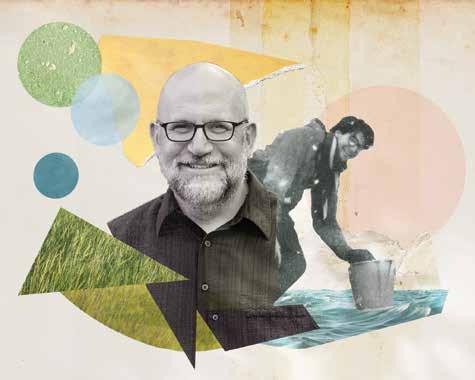
really good friends, even though we’re many generations across Colgate.”
In 2022 Paul was honored with the Society for Freshwater Science’s Distinguished Service Award, which Fuller won in 2019.
Going With the Flow
Brittany Hanrahan ’11 is another biology major who credits Professor Randy Fuller for helping her find her direction. She had declared her major, but was struggling to determine how she wanted to pursue that path. During the Manchester Study Group in the fall of Hanrahan’s junior year, Fuller suggested, “Why don’t you work in my lab over the summer to get a better idea of research and see if you enjoy it?” She’d never done anything like it when she joined him in the Adirondacks to examine streams that were acidified. “It was something that was super interesting and relevant to the effects that humans are having on our environment, and I loved it,” she says. “The thing that had the biggest impact on me was thinking about
how humans had modified our environment in such a way that was strongly impacting the resources around us.”
Fuller taught her everything from learning how to take water samples to formulating a hypothesis. Most importantly, she says, he coached her on being prepared but also flexible. “Because sometimes [being in the field] doesn’t always go the way you want it to, and that’s OK,” she says. “That really helped because he has this wonderful energy about him. He’s so happy and enthusiastic, and he teaches you to go with the flow, which I really needed as a firsttime researcher.”
In the Adirondacks with Fuller, Hanrahan examined how leaves were decomposing in the stream. Later, as an extension of that project, she worked with Professor Cat Cardelús to test those leaves for calcium and nitrogen to see if they had different rates of decomposition. “It was great working with them and getting both of their perspectives — Randy’s perspective from the aquatic area and Cat’s from the terrestrial area — and that drove my later choices for my PhD.”
Before starting grad school, Hanrahan spent a summer interning with the Illinois EPA on Clean Water Act projects that applied to the landscape, specifically agriculture. “In the Adirondacks, we were thinking about acid rain, but where I’m
42 Colgate Magazine Summer 2023
from, which is Illinois, we think a lot more about agriculture. That’s the primary way humans are modifying the landscape and impacting all of the resources around us.”
When she wrapped up the internship and was ready for grad school, Hanrahan received from Fuller a list of advisers at universities to consider. “That’s really important; you have to have an adviser who is going to support you and guide you as a student,” she says. Hanrahan landed at Notre Dame with a professor doing “exactly what I wanted to do — looking at how agriculture was impacting stream ecosystem functions.”
Her time there “was this wonderful full-circle moment,” Hanrahan says. “I started working in the streams, and then we realized that you have to also understand what’s going on in the landscape because agricultural fields and agricultural management so strongly influence what’s going on in the streams that are adjacent to them. We had to start to bridge that gap, which was exactly what I was trying to do with Cat and Randy.”
Hanrahan’s first professional position was with the U.S. Department of Agriculture as a research biologist, thinking about nutrient loss from agricultural fields as well as nutrient transport from streams that are adjacent to these fields to places like Lake Erie or the Mississippi River Basin. “These small-scale problems aggregate to create dramatic effects in places like Lake Erie or the Gulf of Mexico,” she says.
Recently, she started a new position as a physical scientist at the Ohio-KentuckyIndiana Water Center for the U.S. Geological Survey, working on similar issues. Hydraulic technicians provide data that she analyzes using skills she learned in her Colgate biostatistics class. The persuasive writing class she took also is important to her current work because a large part of her job is writing academic papers to share with scientists, farmers, and conservation groups. “The audience is often variable, so I have to be able to communicate our message effectively.”
Last November, Hanrahan, Michael Paul ’91, and several other former students of Fuller’s returned to campus to celebrate his imminent retirement. As part of the celebratory weekend, his former students met with current students. “It was really cool to talk to those students and say, ‘What you’re doing is valuable, especially the research.’ We focused a lot on how transformative it had been for all of us. You can’t always get that at a large university because you may not have that experience with someone. My individual relationship with Randy changed my life.”
Data Analysis for Advocacy C
yierra Roldan ’16 also uses her data analysis and writing skills she learned at Colgate in her daily work. Roldan is deputy director of the Immigration Research Initiative in New York City, where she is responsible for creating reports to influence policy change. “We work with a lot of grassroots organizations that use our data to go to legislators and say, ‘This is why we need to do this program, this is how it would impact people, this is what it would do for the state.’” For example, during the pandemic, Roldan’s work supported the Fund Excluded Workers campaign that set out to help workers who didn’t receive financial relief like unemployment insurance and stimulus checks due to immigration status and/or the type of work they did.
At Colgate, Roldan’s research projects focused on intergroup dialogue and intersectionality. She explains how she uses both in her role at the Immigration Research Initiative as well as her volunteer position as a commissioner with the Human Rights Commission for Schenectady County:
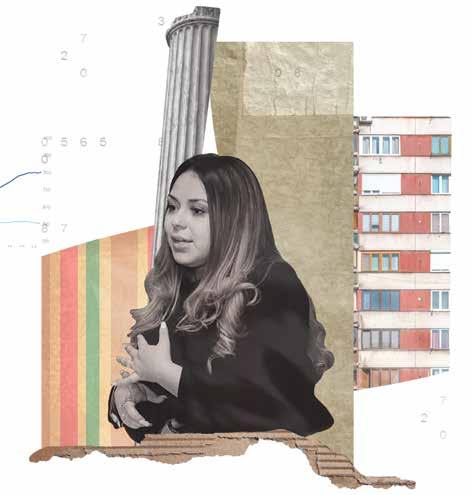
“[Intergroup dialogue] is a form of pedagogy so that people who are different from each other can learn how to dialogue across differences. It’s a way of building connection, getting to know people, and having those difficult conversations about race, gender, and sexuality.
“A lot of the work I do has a lens that looks at status: what positions and occupations people are working, their immigration status, their race, their ethnicity. It’s really an intersectionality. And the research projects I did at Colgate have helped me to think about how to do my research in my career in the immigration field, because people aren’t just an immigrant; they come here with a race, a gender, and a socioeconomic status. That all plays a role in their experiences in the United States.
Summer 2023 Colgate Magazine 43
origin story: colgate’s NIH-based study group
Don Court ’65 built his own physical science major out of math, physics, chemistry, and geology at Colgate. In Court’s senior year, Professor Fred Weyter arrived on campus with the goal of introducing students to more advanced courses in genetics and molecular biology. Soon to come: biology major Bruce Citron ’76. The three would together envision Colgate’s study group at the National Institutes of Health (NIH), which is now called the Bethesda Biomedical Research Study Group.
Court provides the backstory: “In 1972, I joined the National Cancer Institute (NCI) at the NIH. I accepted several students in the ensuing years, including Bruce Citron, who joined my laboratory in 1974 and became the first Colgate student to gain college credit working at the NIH. In the 1990s, Bruce, Fred, and I started the program, giving students the opportunity to spend a semester at the NIH. It not only provided an active research environment for the students but also provided a chance for my postdoctoral fellows to gain
“[The Human Rights Commission for Schenectady County addresses] issues when people are experiencing discrimination. Those conversations are hard, hearing people’s experience about something that was done to them within the community. We are the first to determine if it’s a human rights violation and then we send it to the necessary people who handle these violations and investigate further and take action to remedy the situation.
“[We also] look at changes within the community that would impact people based on their race, gender, things like that. For example, one of our hospitals where a lot of women have their children is closing down, and it’s directly impacting a community that is heavily Guyanese and Black. People who don’t have access to a car to make trips [to farther-away hospitals] have to consider, how do they have their children if the hospital is being moved?”
Roldan’s exploration of intersectionality began with herself, in her sociology classes with Professor Janel Benson. “She pushed
valuable experience as mentors to these younger colleagues.”
Court retired from the NIH in 2020 after nearly 50 years in molecular biology and genetics research. His research was dedicated to understanding how a gene or set of genes can be turned on and off during cell growth.
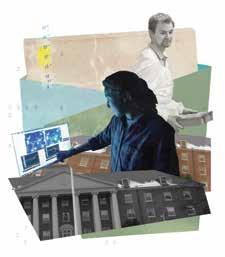
“In the 1970s, it was known that cancers were rogue cells that had lost normal control over the functioning of their genes, and this loss of control could lead to uncontrolled growth and cancer. At the time, human cells were difficult to study, so I used a simpler system to understand how genes turned on and off. This system used the laboratory strain of E. coli and lambda, a virus that infects this bacterium. Through the years, I developed new technology using these simple organisms that allowed us to rearrange their genes and chromosomes by using special techniques of recombination, which we named recombineering. This technology was patented by the NIH and is now used by many laboratories to engineer and modify the chromosomes of simple bacteria and complex organisms.”
Court is still active at the NCI through an NIH emeritus position. “Recently, I have been advising researchers to better understand the coronavirus, and the NIH has just patented our new technology for vaccine development.”
me to think about questions I never thought about before: who I am and why I am the way I am. My life experiences are because of many different factors, and again, the intersectionality of my identity. I really got to explore who I was.”
Roldan obtained her master’s of public administration with a concentration in homeland security from the Rockefeller College of Public Affairs and Policy.
Chemistry Co-lab
Get to know Kevin Gardinier ’94, vice president of discovery research at Karuna Therapeutics:
“I joined Professor Ernie Nolen’s [chemistry] lab, and he introduced
me to an ongoing project he had in collaboration with a lab at the University of Louis Pasteur with Professor Jean-Marie Lehn, a Nobel laureate from 1987. Professor Nolen’s lab was making a Janus molecule (a molecule that has two hydrogen bond faces), and that molecule would interact with the molecule that was being made by the lab at University of Louis Pasteur. The whole concept was that the information encoded within each molecule would help make a super molecule array when put together.
“My undergraduate research was published during my senior year. This was a very energizing result of the Colgate research experience and inspired me to continue pursuing my chemistry graduate degree.
“This research laid the foundation for the rest of my career. I learned how to form a hypothesis, test it, and redesign it if needed or move on to the next step if the data was supportive. That whole process is essentially everything I have experienced throughout the rest of my career.
44 Colgate Magazine Summer 2023
“I did my PhD at UC Berkeley, in synthetic organic chemistry, and then went to do a postdoc in Jean-Marie Lehn’s lab from 1998–2000.
“I started my career at Eli Lilly and Company in 2000, in the medicinal chemistry department. I worked in the neuroscience division and rose through the ranks for 17 years. At the end of 2016, I joined the Novartis Institute for Biomedical Research in Cambridge, Mass., and was director of medicinal chemistry for about five years.
“At Karuna, I lead a department of chemists, biologists, and representatives from all functions associated with drug discovery. Karuna is focused on psychiatric and neurological diseases, and we currently have a molecule in phase three development for schizophrenia. My department’s job is to come up with the next generation therapeutics for the neuroscience space for psychiatric and neurological diseases.”
Becoming a WellRounded Scientist

Matthew Feeney ’14 describes the summer after his junior year as “intense” research in Wynn Hall with Professor Ernie Nolen. “I’d had the lab class experience, but it’s a whole new beast when you’re starting a project under the direct supervision of a tenured professor,” Feeney says. “I was still learning the tools of the trade and in some ways proving that I was sure with my hands, but I really credit that summer with kick-starting my career.”
He continued the work his senior year, with Nolen publishing his senior thesis afterward. “That was a really cool aspect of my undergraduate research experience — being able to do work that not only was important for a project but also was able to get me authorship on a manuscript in an actual scientific paper.”
In graduate school at Tufts University, Feeney’s chemistry knowledge evolved into learning how to make coatings that respond to light in different ways. “I took the baseline knowledge and skills I learned doing organic chemistry and put them into an applied setting to make physical materials for various applications.”

This preparation relates to Feeney’s work today as a scientist at Akita Innovations. A small chemical company, Akita handles projects for government and nongovernment clients, with the goal of finding chemical solutions for institutions’ problems. One of the main projects Feeney has been working on is developing new coatings and paint for U.S. Army vehicles that resist chemical warfare agents. “It is the scientific method: We have a hypothesis, we make molecules that address the hypothesis, and then we test to see if we had good ideas or if we were way off track.”
There are new challenges in this applied world, Feeney says — number one being cost. “When you’re making carbohydrates in a lab at a small scale, you don’t necessarily need a ton of material to work with, so cost is less of a concern. But when you’re working with the Army and you’re potentially developing a paint that they are going to use for tons of their vehicles, they can’t be spending $50,000 per gallon of paint,” he says. “So not only do you need to develop the chemistry, but you also have to do it in the confines of what is realistic and commercially viable.”
Problem-solving as well as learning how to write and communicate are Feeney’s biggest takeaways from his Colgate experience. Beyond the importance of learning lab skills, he says, “I really feel like I was a well-rounded scientist coming out of Colgate.”
Feeney met his wife, Jenna (Glat) ’14, in chemistry class when they sat next to each other in their first-year CHEM 101 lecture. They started dating that summer and married in September 2021.
Unexpected Pathways P
articipating in the National Institutes of Health (NIH) Study Group as a Colgate student, Jamie Timmons ’04 worked in a cancer biology lab, researching how cells normally work and what goes wrong in cancers — “cells that are growing that shouldn’t be, and they’re not dying when they should be,” she summarizes. Today, Timmons works at Amylyx Pharmaceuticals, where scientists study neurodegenerative disorders (e.g., Alzheimer’s, ALS, and Parkinson’s). “It’s almost the exact opposite,” she notes. In these diseases, “cells are dying when you don’t want them to be. A lot of the pathways that are implicated in cancer, they’re also messed up in neurodegenerative diseases, but for the opposite reason.”
Timmons’ current role as global head of medical strategy and communications at Amylyx is a twist on her intended career. She was a pre-med student at Colgate and went on to work at Dana-Farber Cancer Institute (taking over a job left by another alumna). She then attended medical school at the University of Pennsylvania and did her residency in internal medicine. Afterward, Timmons was feeling burned out and wanted to try something different, so she started working for a medical communications agency. Amylyx was one of their clients, and she was “drawn to their mission.”
There, she works with physicians and patient advocacy groups to gain an understanding of the science, develop publications and presentations, train her internal team to be experts in the disease state, and work with the clinical development team on how to communicate the results of clinical trials to a variety of audiences, including the FDA. “The work I did at the NIH was especially helpful in understanding how to quickly review data, understand it, compile it, and then make it presentable to different audiences,” she says.
“This was not my planned career path — I didn’t even know this job existed during college — but I think those are the best careers, the ones where you end up seeing different opportunities and following them.”
Summer 2023 Colgate Magazine 45
“NOT ONLY DO YOU NEED TO DEVELOP THE CHEMISTRY, BUT YOU ALSO HAVE TO DO IT IN THE CONFINES OF WHAT IS REALISTIC AND COMMERCIALLY VIABLE.”
MATTHEW FEENEY ’14
Read about current students’ experiences at colgate.edu/summer-research-2023.
Endeavor
Immersive Worlds of Wonder
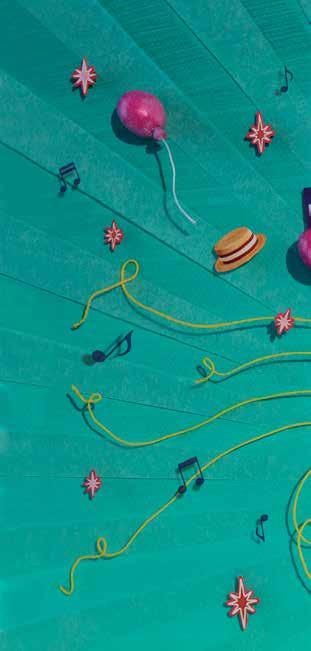
In the midst of the COVID-19 lockdown, Robert Drury ’99 started an in-person experiential event company. While he acknowledges this “may not have seemed like the most logical step,” it was actually a calculated move for the marketing professional. Drury anticipated that as the world emerged from the pandemic, people would be hungry for connection and live events, and he had 20 years of experience to back it up.
As managing director of TV and media at CSM, a global integrated marketing agency, Drury developed and spearheaded major experiential events for shows like Stranger Things, The Walking Dead, and The Handmaid’s Tale. Now, he’s bringing this combination of innovation and experience to his own company, Cartwheel and Co. Marketing.
Working at AOL after graduating as an economics major at Colgate, Drury first learned about event marketing, which has since become experiential marketing. “It combines everything I’m interested in,” he says.
Throughout two decades at CSM, he led the growth and evolution of this burgeoning industry — which screeched to a halt when COVID-19 hit in 2020 and the pandemic decimated live events companies. While many shuttered, Drury anticipated that experiential marketing would bounce back. “The pandemic felt like a blip in its growth, as opposed to being earth shattering,” he says. “It was just a matter of time” until people would be eager for a return to inperson events. “It was a really good time to lay the foundation for Cartwheel.”
Drury created a website, informed his CSM clients that he was striking out on his own, established the company infrastructure, and devised a sustainable, scalable agency model that capitalized on the flexible work options and gig economy normalized by the pandemic. He started with a lean team of two and hired freelancers to tailor the company to specific projects. “We use the term ‘accordion style’; our team compresses, expands, and contracts along with our projects, which gives us a much lower overhead and takes a lot of risk out of any given quarter,” Drury says.
His preparation paid off. Developing the company during the pandemic meant that
as soon as people were ready for in-person events, Cartwheel was ready for people. “There was a real backlog of ideas and pent-up energy, and it exploded; 2022 saw a massive boom in events,” he says. “If I had been just one month in at that point, I don’t think I would have been able to handle the volume of requests we got.”
Cartwheel was inundated with opportunities to pitch campaign ideas for major TV and film clients. “Everything is a creative best-idea-wins grudge match. It can be extremely competitive, but also very rewarding,” Drury says. “A lot of what I do all day is come up with new ideas to engage people in TV shows, which is a ton of fun.”
The first project he and his team took on was an experiential event for the Netflix hit The Queen’s Gambit, for which Cartwheel
46 Colgate Magazine Summer 2023 Illustration by Pushart
marketing
Robert Drury’s experiential event company invites people into real moments of the shows they love.
There was a real backlog of ideas and pent-up energy, and it exploded; 2022 saw a massive boom in events.
won a bid to create an immersive experience to draw people into the world of the show. During Emmy season, they created a life-sized chessboard at the Grove in Los Angeles, complete with a 15-foot pink queen, open-play chess tables, and a match between two women: a 12-year-old prodigy and a 19-year-old master. The installation drew 7,000 people in three days. “It was a good calling card,” Drury says. “We were able to say we just worked on a really big show for a big network — and we were off to the races.”
The success of that event led to more campaigns, for The Marvelous Mrs. Maisel, WrestleMania, and Outlander, among many others, and Cartwheel’s client roster expanded to include some of the industry’s heaviest hitters like Prime Video, NBCUniversal, Lionsgate, and STARZ. With
just $7,500 in start-up costs, the company generated $6.28 million in revenue in 2022 and was named Newcomer Agency of the Year by Ad Age.
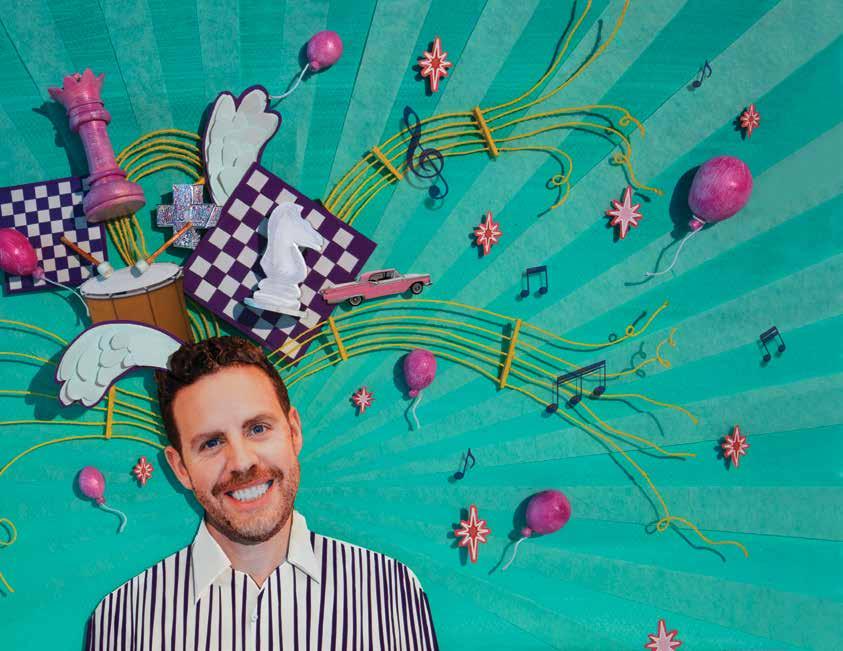
So, what’s the draw for these immersive events? Why do they attract crowds who wait for hours just to get in? Drury understands the allure: “When I was a kid, you’d like a TV show and that was it. Now,
there are so many opportunities for fans. Experiential events give fans the chance to see and feel the worlds of the shows they love.” The motivation for attending — and developing — such events goes beyond fandom, he says: “It’s about creating moments for people, from grandparents to kids, to experience together.”
Summer 2023 Colgate Magazine 47
— Lara Ehrlich
The first project he and his team took on was an experiential event for the Netflix hit The Queen’s Gambit … they created a life-sized chessboard … complete with a 15-foot pink queen.
Environment
Flower Power
In mid-20th-century America, a Jewish saying — tikkun olam — became popular among people interested in social action efforts. The phrase translates to “repairing the world,” and in the 1960s, it was often synonymous with performing social justice actions.
Certified landscape designer Lynn Becker ’78 aims to put the adage into practice through her business, Trout Lily Garden Design. “I’ve taken it to mean [something] more literal: really repairing the world,” she says. “What I explain to my clients is that I can’t [totally] fix how messed up this planet is by myself, but I can do my piece by repairing one garden at a time.”
Becker keeps earth’s longevity at the forefront of her designs through two main principles: modeling her landscape designs around native plants and incorporating pollinator-friendly flora into her clients’ gardens. “Climate change has dramatically altered what we can do” when it comes to planting gardens, she notes. Plants that
would’ve survived hot summers decades ago now shrivel and die in the blazing heat, and invasive plants and insects that would have perished in the winter freeze are still kicking come springtime. With this mind, Becker’s mission becomes even more urgent: She keeps on with tikkun olam for the futures of her children and grandchildren.
Becker’s idea to prioritize native gardens isn’t a new concept, but it’s one that has gained traction in recent years. “For a while, native gardens got a bad rap because they weren’t all that attractive,” Becker says. In order for native gardens to be effective, she explains, they have to be beneficial to the environment, designed by knowledgeable designers, and, most importantly, be beautiful.
Native plants, according to the National Wildlife Federation, “have formed symbiotic relationships with native wildlife over thousands of years, and therefore offer the most sustainable habitat.” They also generally require fewer fertilizers and
pesticides and less water than non-native plants, remove carbon from the air, and help preserve biodiversity. In Westchester County, where Becker operates, wild bergamot, Northern blue flag iris, and Smooth blue aster are common flowering native plants.

Pollinator gardens often go hand in hand with native gardens by creating a hospitable habitat for beneficial insects such as bees and butterflies. Becker chooses native plants for her clients’ spaces that help wildlife thrive.
Those species fare better than on the neatly manicured, grass-only lawn that became popular in post–World War II America. Becker’s own garden is a testament to this phenomenon: “Last summer during the drought, I’d look out my door in the morning when I got up, and I’d see the butterflies and the bees, and all the insects buzzing, and my neighbors just have lawn and it’s [looking] dead,” she says.
Gardening as a career is Becker’s “second act.” She started out as a lawyer, once working for the New York Mets and later for Simon and Schuster. After stints in legal recruiting, writing for lifestyle magazines, and substitute teaching, Becker took an audit of her career. Her friends spoke about how much they enjoyed their work, and while Becker had good times, she seldom felt emotionally connected to her jobs. One activity she had always found meaningful was gardening.
She’d puttered around in the gardens of her childhood with her father, but “nobody ever told a girl in 1965 that there was a career in gardening,” Becker says. So, after she became an empty nester, she took classes at Westchester Community College, through a program on native plants in conjunction with the Lady Bird Johnson Wildflower Center at the University of Texas at Austin. For the first time, Becker began envisioning gardening not as a hobby, but as her next career. She wanted to be taken seriously.
Becker spent the next five years working through the New York Botanical Garden’s Landscape Design Certificate Program, followed by founding Trout Lily Garden Design. She’s been practicing tikkun olam ever since.
Now 67, Becker sees gardening as her endgame. She takes inspiration from British designer Gertrude Jekyll, who was designing English gardens until her late 80s.

“I can do this for the rest of my life,” Becker says.
— Rebecca Docter
48 Colgate Magazine Summer 2023
The namesake of Becker’s business blooms in early spring. Trout lilies thrive in woodland habitats, providing food for pollinators like bees. don hamerman
Landscape designer Lynn Becker ’78 thinks about climate change as much as aesthetics when she styles gardens for her Westchester, N.Y., and Fairfield, Conn., clients.
Telling The Handmaid’s
Tale
Catch up with writer Jacey Heldrich ’08 ahead of the show’s sixth and final season.
Recently, from her California living room, Jacey Heldrich ’08 learned how to make IEDs and other explosive devices.
Don’t worry: She isn’t planning on practically applying this knowledge that she learned through Google searches and YouTube videos. But a character on the Emmy Award–winning TV series The Handmaid’s Tale likely will.
To make the show seem realistic, and to nail its dystopian genre, she and her writing team also take inspiration from world events. Then, they pen the worstcase scenario of those times, revealing consequences that could affect society in the long term. This model comes straight from writer Margaret Atwood, who structured much of the novel on which the show is based around the 1970s Iranian revolution and the rise of conservative Christianity during the Reagan administration.
Heldrich doesn’t have to time travel that far back to find material for each plot point. In the show, women are stripped of their reproductive rights and are seen as surrogates in an authoritarian government. In America today, access to abortion and contraceptive care are being hotly contested in court — something that happens in the show’s flashback scenes.
pregnancy crisis center where anti-abortion employees attempt to convince her to keep her baby. The aim of the episode was to show the lengths people seeking abortions have to go to receive adequate care. “Everything was cribbed from documentaries, from interviews, from YouTube videos where girls go undercover at these crisis pregnancy centers and record what’s said to them,” Heldrich told Vulture last year.
Writing for a post-apocalyptic drama that deals with themes like rape, violence, and death isn’t easy, and it can be a more emotional process than other TV shows, she says. Rather than watching TV at the end of a long day, Heldrich will spend time with her young daughter, who reminds her that there’s a world outside of Gilead, the fictional hellscape at the center of the show.
The Colgate English major had been working as a television assistant for five years when she arrived at The Handmaid’s Tale’s writing department. She started out assisting the writers of the show by joining the group as they outlined the program’s episodes and season as a whole. “I was really lucky to land on Handmaid’s Tale when I did, because the television assistant track is something that’s been pretty entrenched as a way for people to break into professionally,” Heldrich says.
Soon, she had the opportunity to flex her own writing muscles. “Witness” (season three, episode 10) planted the seeds for how the third season would ultimately end. The episode performed so well that Heldrich earned herself a spot as a writer on seasons 4–6. It’s an impressive feat, considering that the move to shorter TV seasons makes writing opportunities even more competitive because there are fewer episodes to work on.
As a writer for the show — which enters its sixth and final season next year — Heldrich has to learn the practical knowledge behind such heinous acts of violence, so characters’ actions are believable to the show’s growing audience. “You have to create that emotional experience,” she says.
“It’s hard because the show has been very emotional given everything that’s happening in the world,” Heldrich says, especially in regard to recent watershed moments in the abortion rights debate.
For example, when supporting character Janine becomes pregnant in a flashback during season four, she timidly enters a
In the meantime, Heldrich will continue learning how to make bombs.
— Rebecca Docter
In 2022 Heldrich and other writers for The Handmaid’s Tale were nominated for a Writers Guild of America award for their work on season five.

Summer 2023 Colgate Magazine 49 endeavor On Screen
hulu
SALMAGUNDI
Outside of the garden projects, two initiatives I worked on included research on best practices for sustainability in the office, which I used to update an existing Green Office checklist for faculty and staff [members], as well as research on ways that the Office of Sustainability could support the existing end-of-year Salvage Program that the COVE runs to increase the program’s efficacy and positive environmental impact. I loved this work so much because it combined an extremely diverse range of work. One day I would be in the garden, the next doing research on important sustainability topics, and the next tackling miscellaneous tasks like reorganizing and finding a home for thousands of extra donated hangers or cleaning and counting reusable utensil kits that the office lends to students during the semester.
Rewind
On-Campus Summer Gigs
Readers remember their jobs at Colgate during the sunny season.
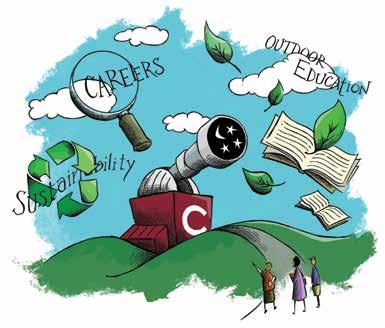
Shana Shapiro ’19, Outdoor Education’s Wilderness Adventure coordinator, 2018
I had an awesome experience! I organized the trips and managed summertime programming. I was responsible for organizing food and gear for the trips, securing wilderness permits, facilitating arrival and departure days, and more. Since a large portion of the incoming firstyear class goes on a Wilderness Adventure, it was super rewarding to help the trips come together and see so many people having fun, safe, and welcoming experiences. Outside of work, I had the chance to live in Hamilton [when it wasn’t] the busy school year, and there was a great community to share it with.
Brenna McConnell ’24, Office of Sustainability intern, 2022
I worked on a team with four other
interns. This role was flexible and varied, as we worked on a large variety of sustainability initiatives across campus. A big part of the work during the summer was working in the Community Garden, which we had the chance to cultivate for the first time in its new location. The team completed the laborious task of bringing in fresh soil to create the rows and beds in the garden, planted and seeded the whole space, and weeded and watered several times per week. We learned organic farming practices, which was particularly important when we were attempting to deal with an aphid problem in the rows with greens like lettuce, kale, and bok choy. Some cool gardenrelated projects that we worked on included building and registering a Little Free Library that sits next to the back gate, as well as research on what types of native plants would be the best to use for a pollinator garden.
Kim M. Wilborn ’89, tour guide, 1987 Worked for admissions! I would give my future husband a tour. My time in Hamilton during the summer was really special. I house and dog sat for Professor Michael Johnston while he and his family enjoyed a summer abroad in London related to his research. The memories range from specific — 4th of July parade — to overarching. I have wonderful pictures of the parade that depict the true small-town, Americana, theme of Hamilton. Summer in Hamilton was about more than living on my own, figuring out grocery shopping, etc. I made such unique and special friendships over the summer. They would be a treasure through my remaining years on campus. There is something indescribable about the band of students who remain and the quieter campus of summer.
Rachel Plasky ’25, Career Services Job Skills Accelerator, 2023 [The accelerator] was one part professional development sessions, one part alumni shadowing, and one part credentialing. For the professional development sessions,
all of us participated in workshops led by various Colgate staff [members], related to such topics as leadership, networking, LinkedIn, and effective communication. These sessions really boosted my confidence in navigating the professional world: Not only do I know how to represent myself well on my résumé and LinkedIn, but I also feel less daunted by connecting with alums and generally asserting myself professionally. Each of us was also paired up with an alum for a “micro-internship,” which consisted of a combination of shadowing and assignments. I worked with Lisa LeeTrostle ’12, head of North America communications at H&M, and I had the privilege to sit in on some of her meetings and review a major report. As an English major, it was helpful to gain insight into one of the potential career paths and see how modernday jobs function. To round out the experience, we all completed a credential, which is a kind of course that focuses on professional skills not always taught in the classroom. My credential was the Poynter ACES Certificate in Editing course, and I found that learning the formal rules of editing paired well with my hands-on experience with the revision process.
Fairuz Ishraque ’22, astronomy research assistant, 2019
I worked with Professor [Tom] Balonek as an astronomy research assistant at the end of my first year. I helped maintain the 16-inch telescope as well as use it to detect flares in a number of quasars we were routinely observing. Later I helped run the telescope for the observational astronomy course ASTR:312 in fall 2019.
I was fortunate to be involved closely with the observatory in one way or another for most of my time at Colgate.
Did you have a summer job on campus?
Write to us at magazine
@colgate.edu.
Summer 2023 Colgate Magazine 97
Illustration by Bernie Freytag
Curate a collection of unique musical instruments
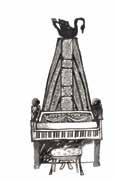
Host ESPN’s SportsCenter with David Lloyd ’83
Mediate the Dominion v. Fox case

Attend commencement with a jazz legend
Croon along with Johnny Hartman p.25

Design an environmentally conscious garden

Write an apocalyptic TV show
Impersonate President
Calvin Coolidge
Feed a campus
Rediscover yourself in Paris p.8
Start your own molecular testing lab p.89
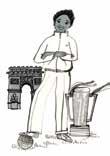

Run a calf maternity ward
Track down looted artwork
jill calder In This Issue 13 Oak Drive Hamilton, NY 13346-1398
p.68
p.24
p.71
p.48
p.63
p.76
p.12
p.84





























































 By MARK WALDEN
By MARK WALDEN

































